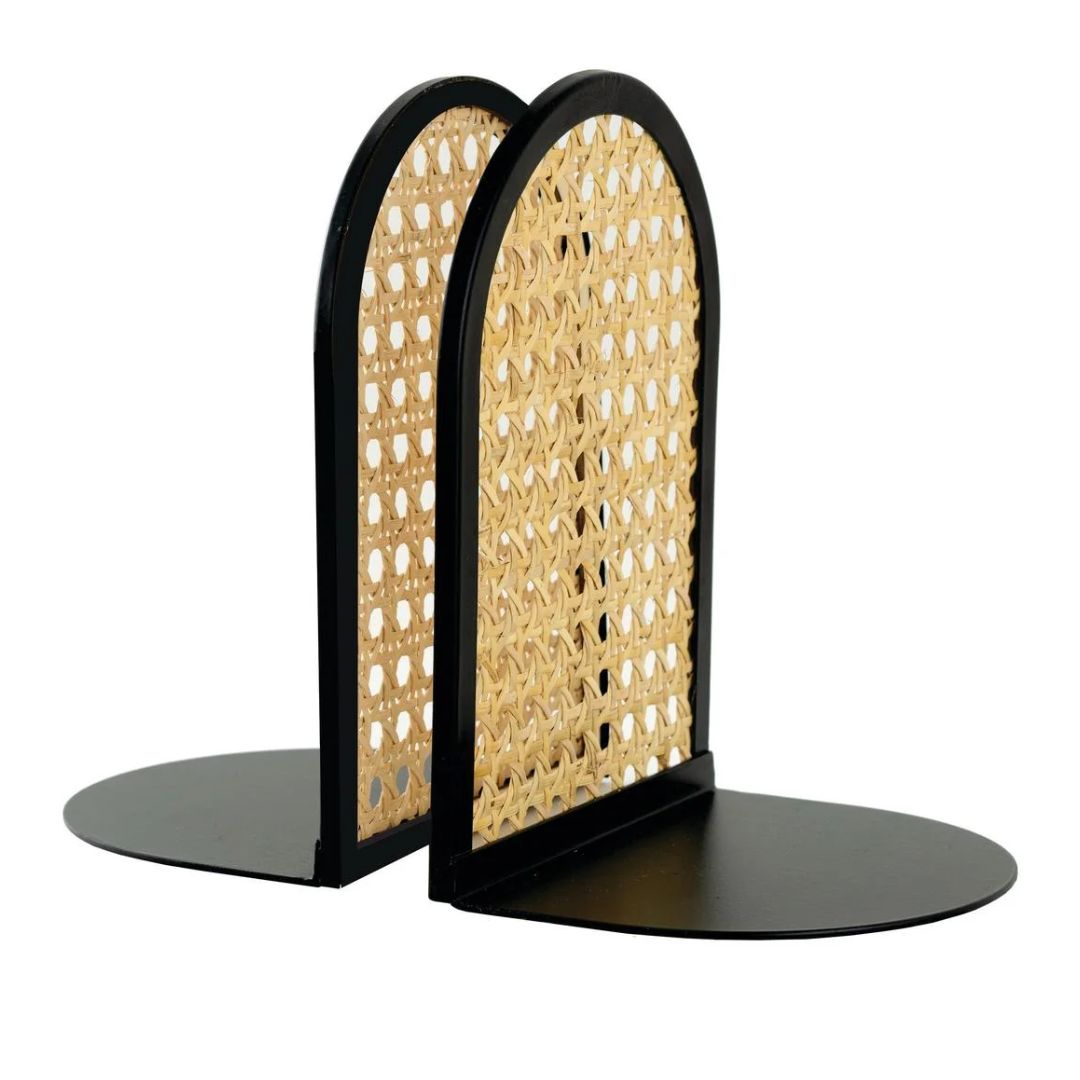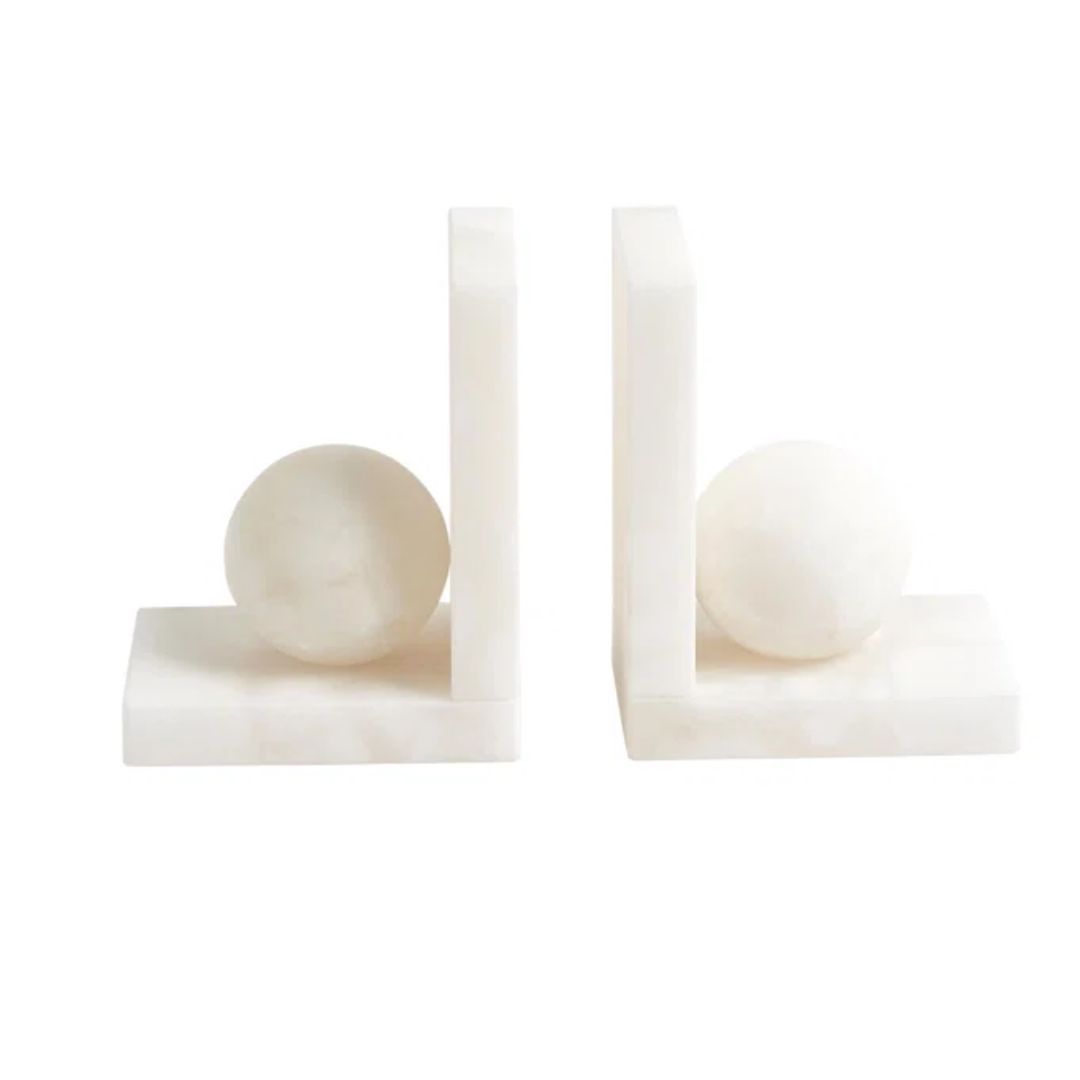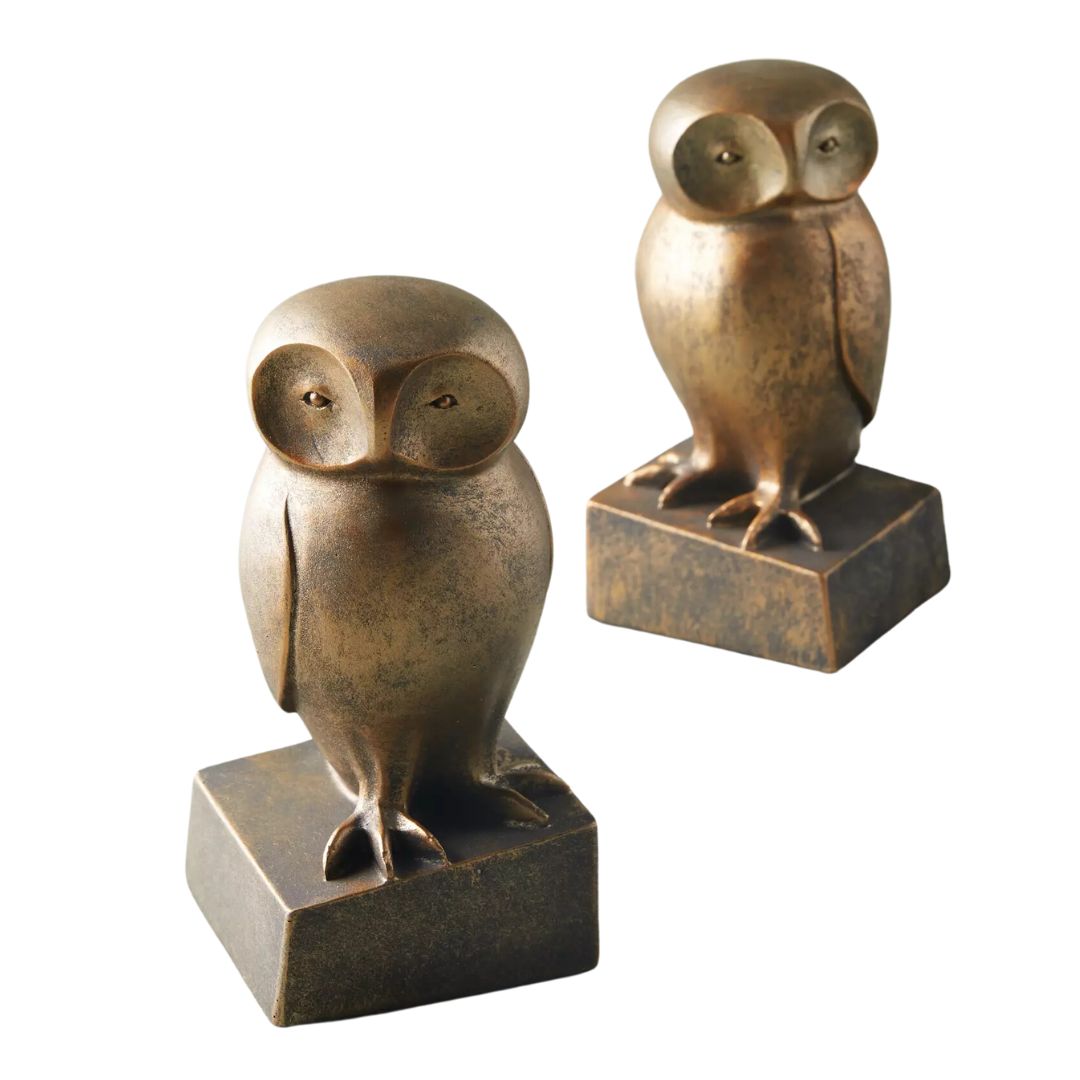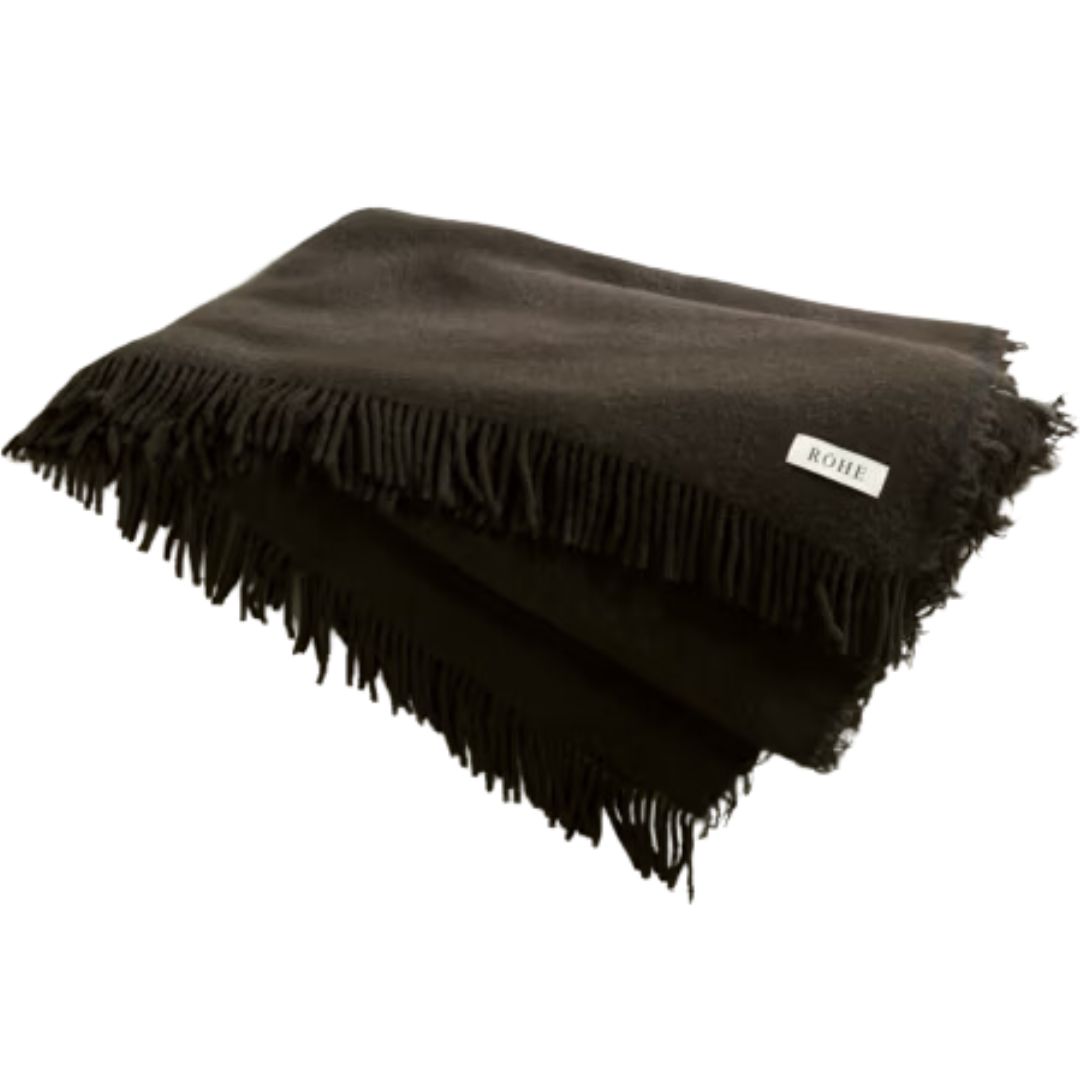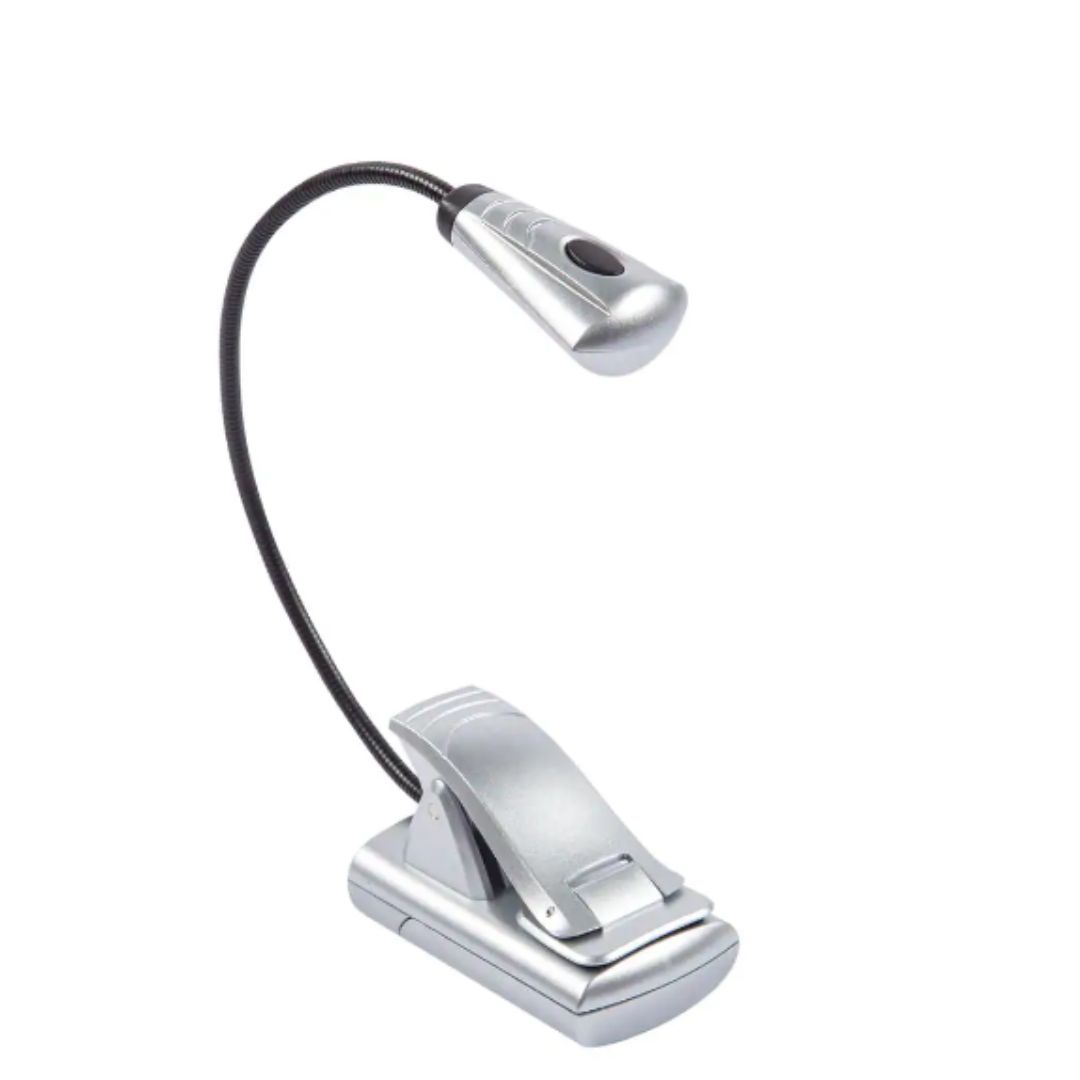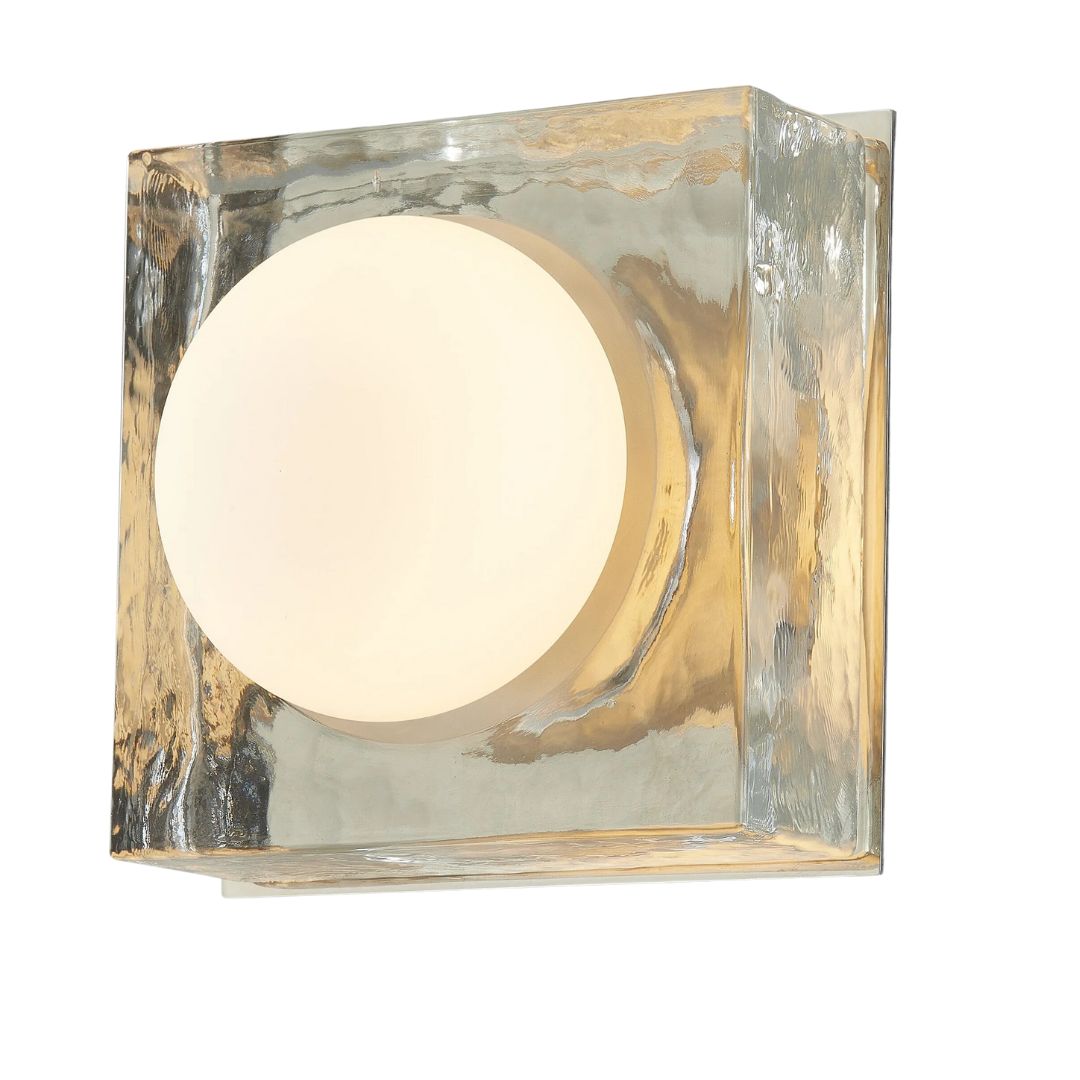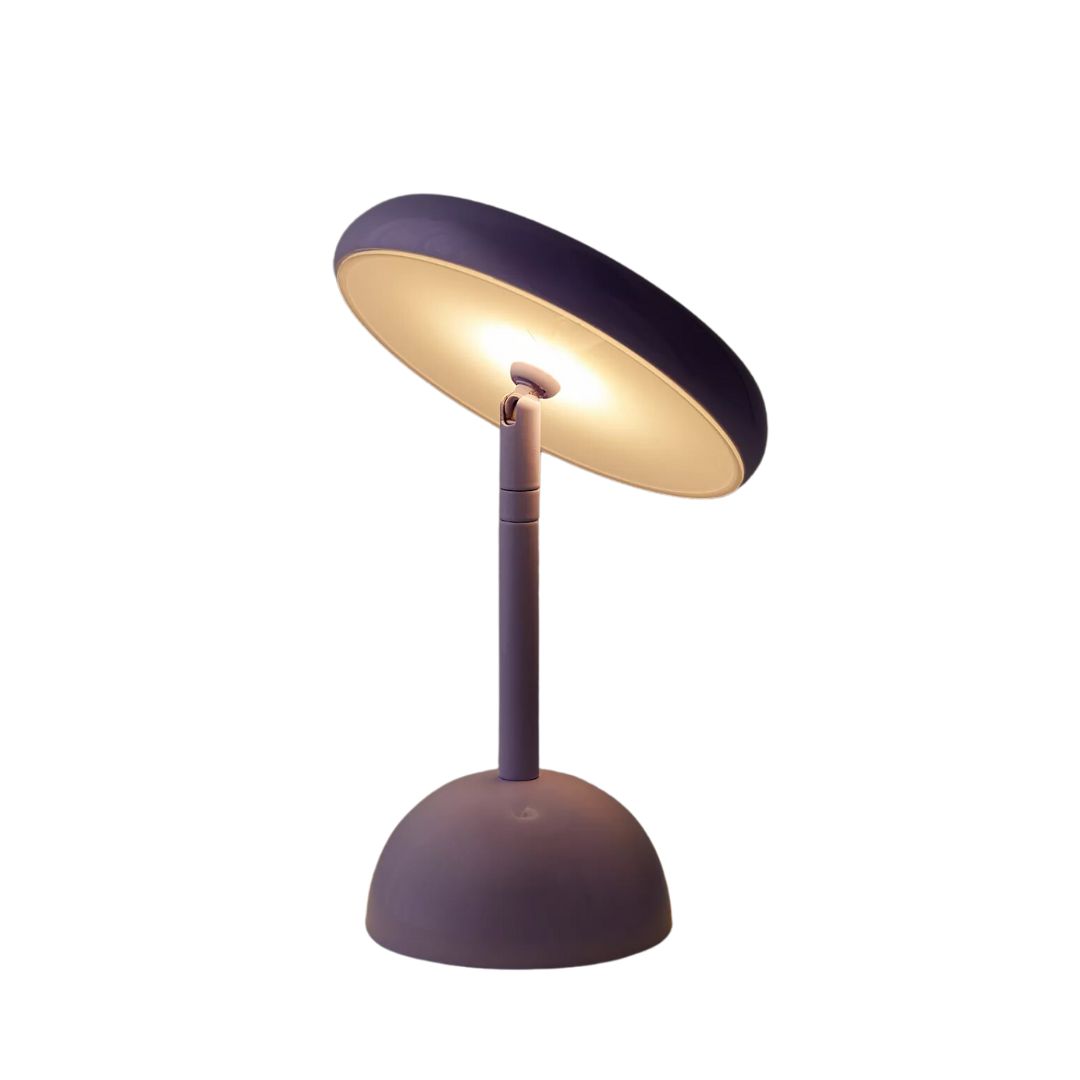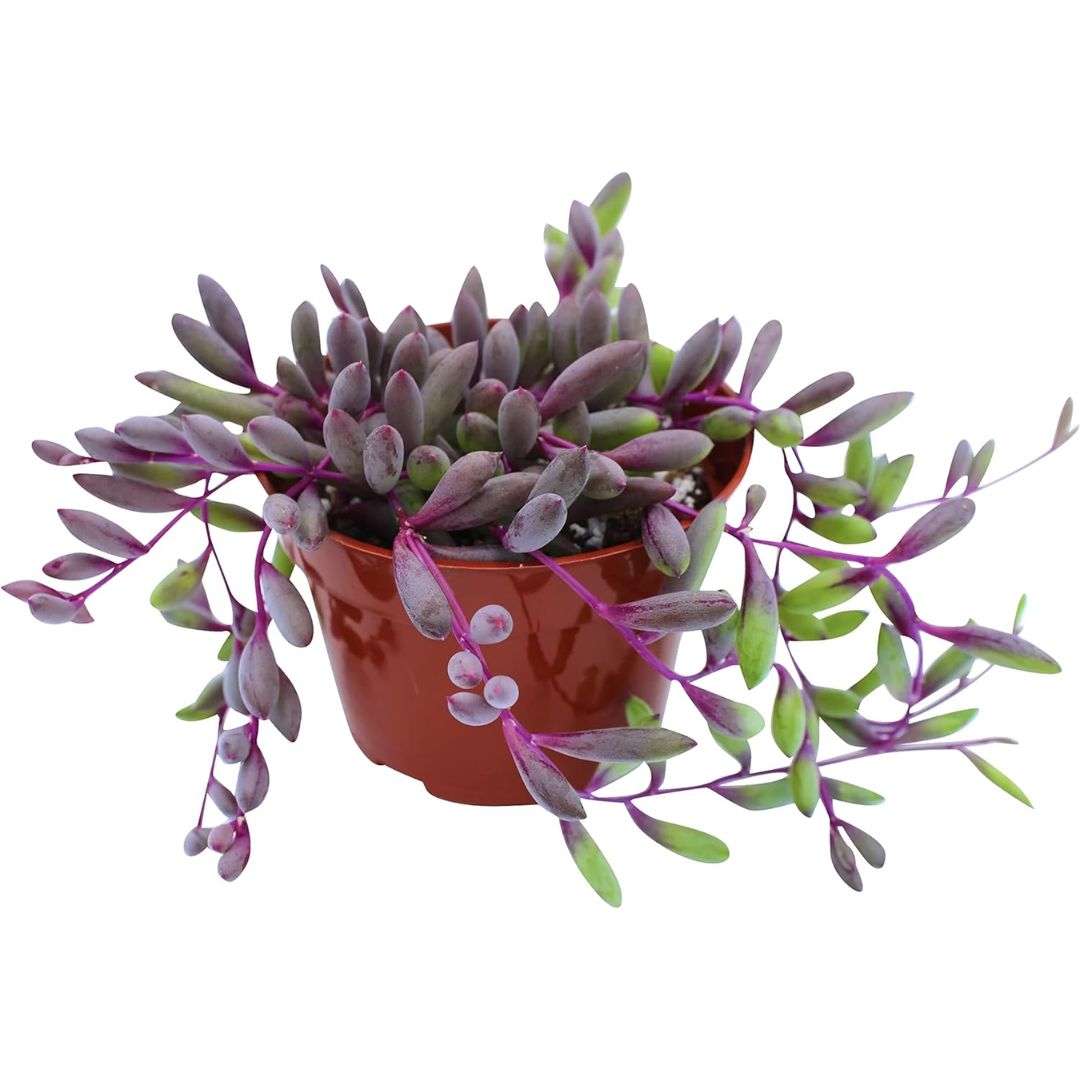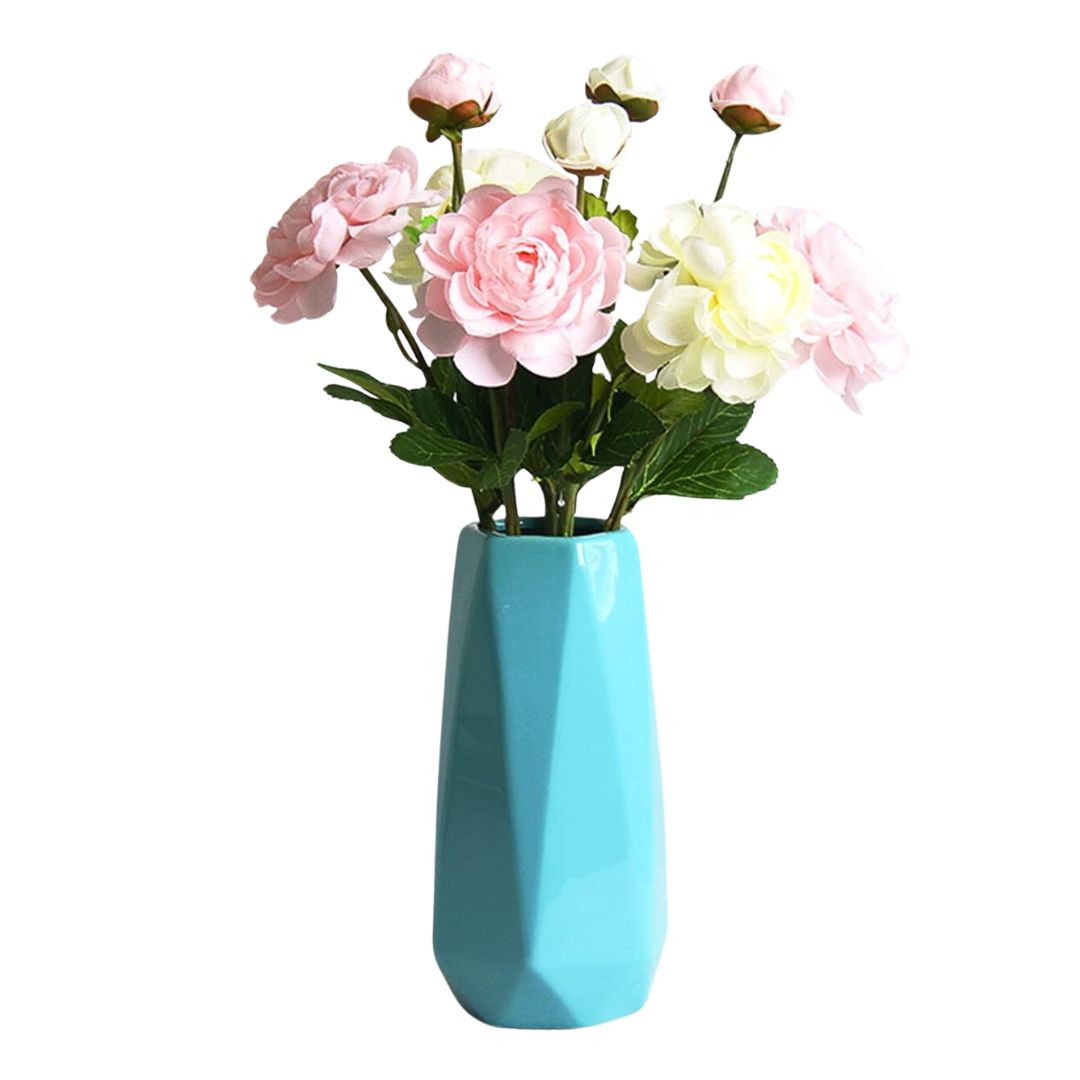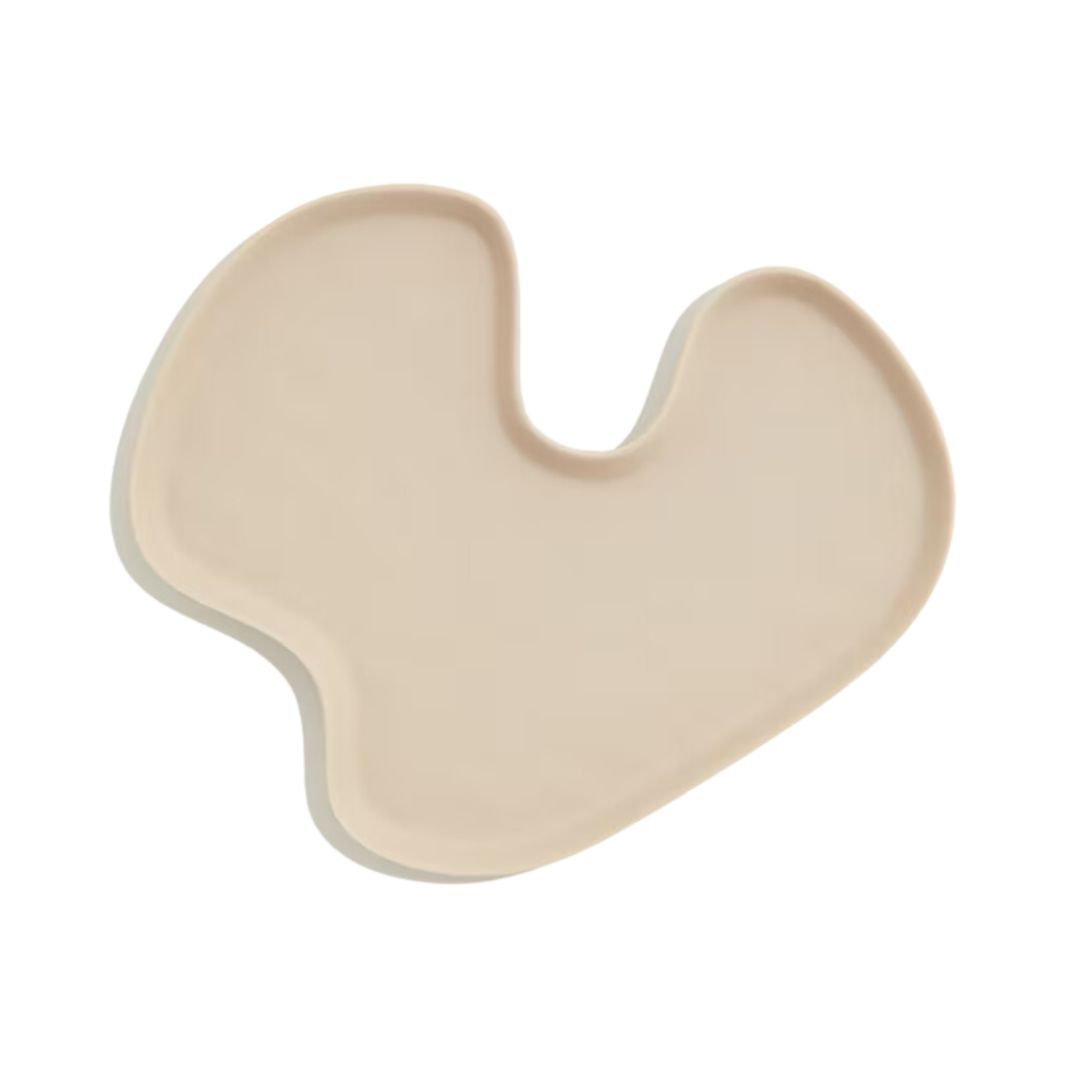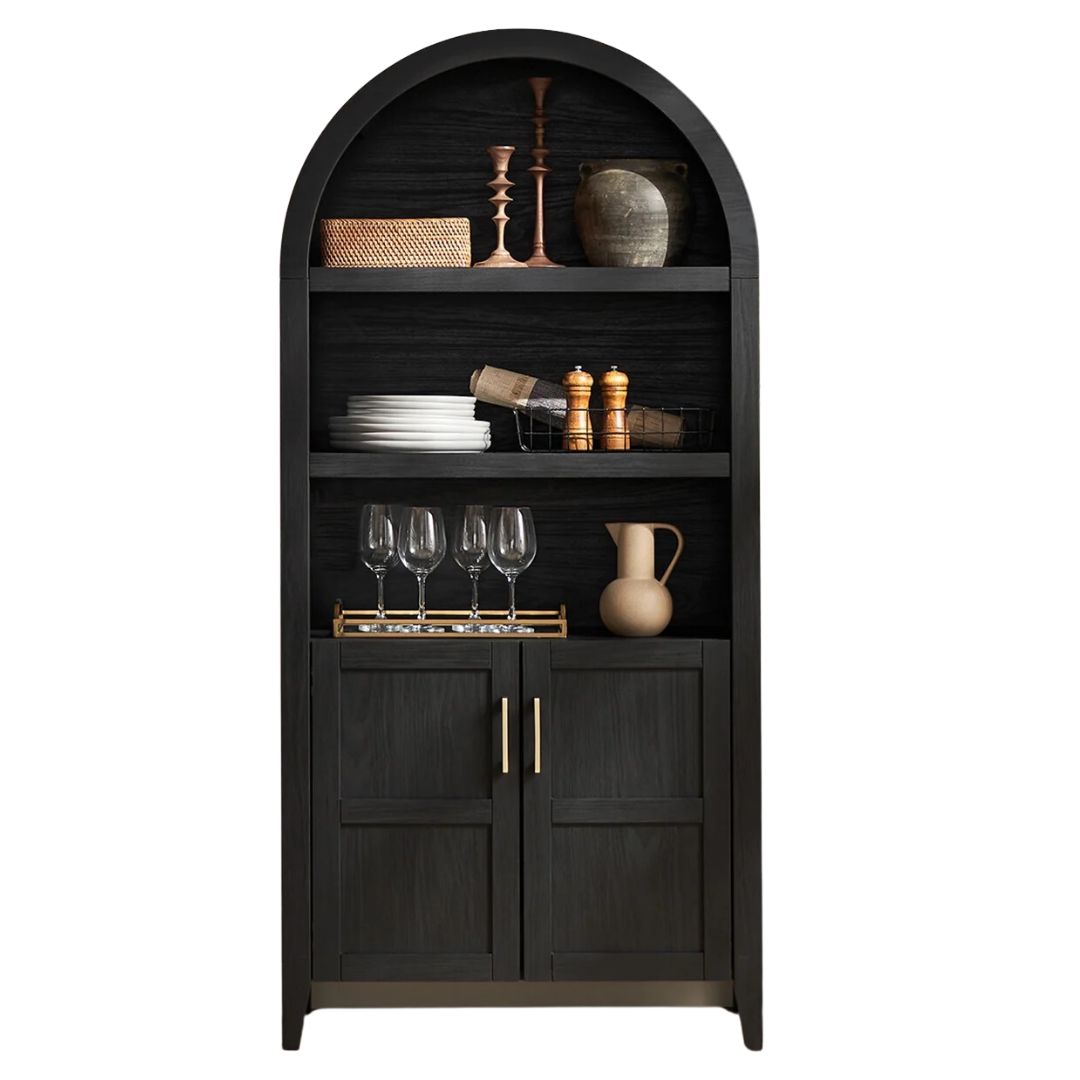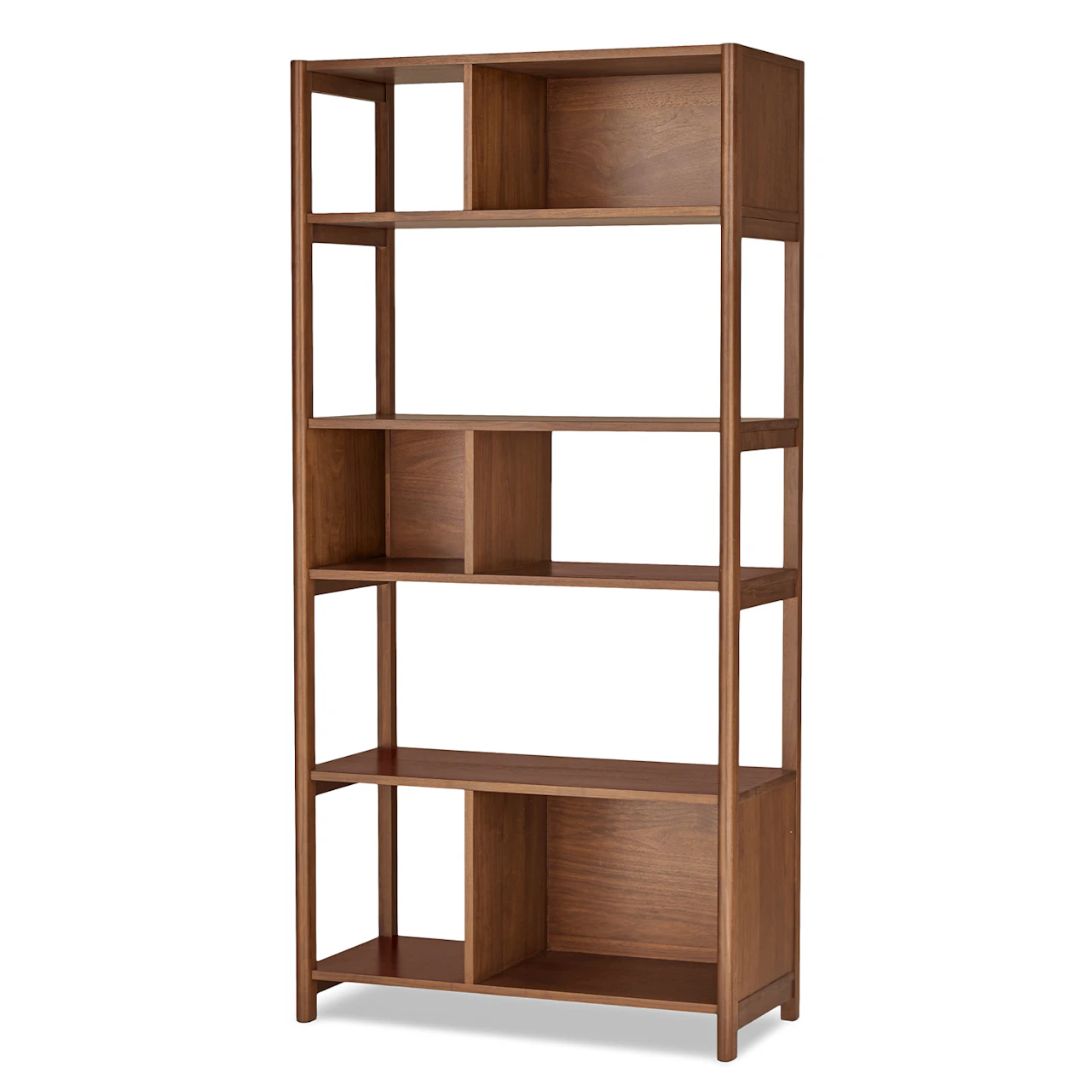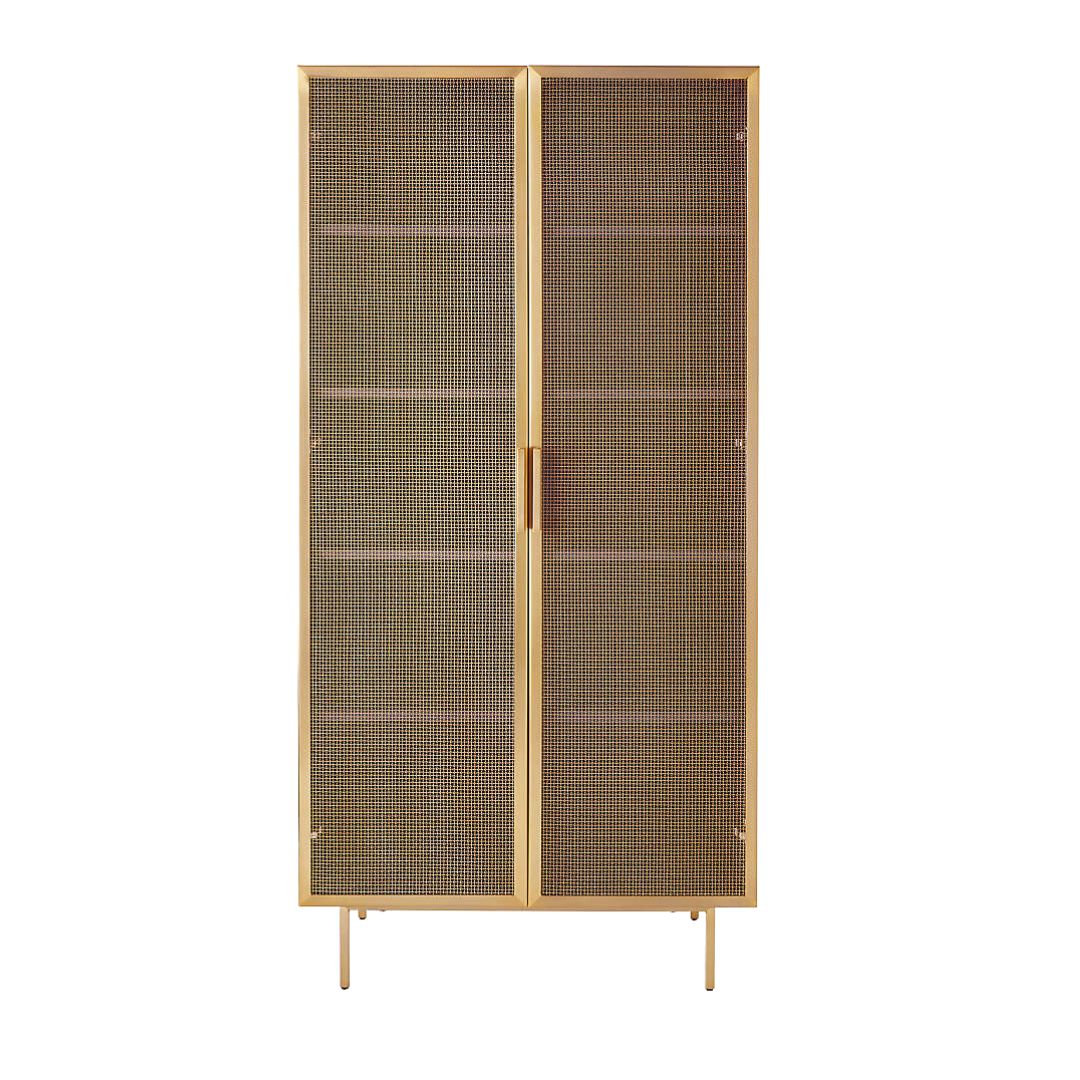Home Library Ideas — 21 Cozy and Welcoming Designs Fit for Homes of all Sizes
From large rooms to small nooks, these libraries are truly dedicated to the timeless pleasure of reading
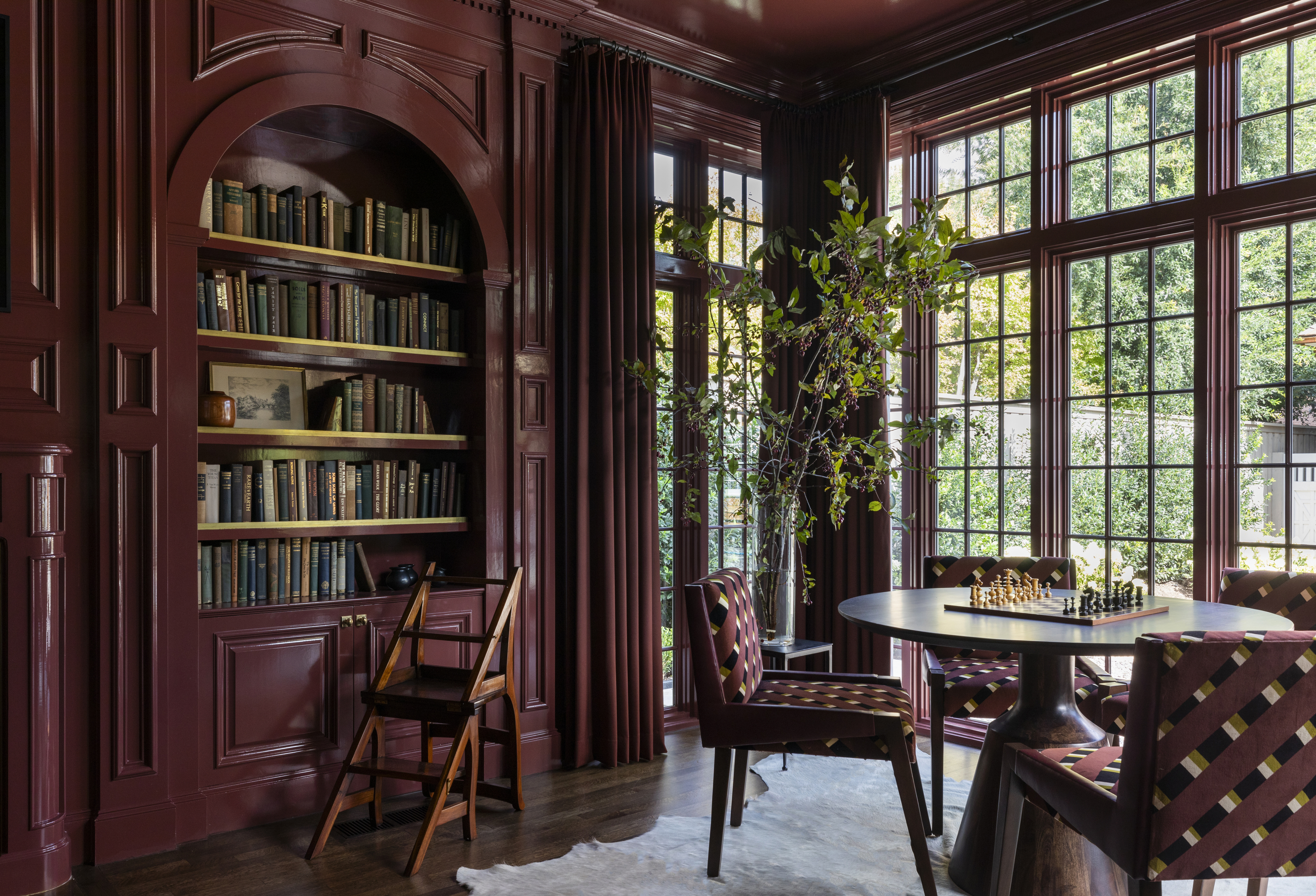

It's every book lover's dream to have a home library. And that doesn't mean it needs to be a large, expansive room stacked with books reaching the ceiling (although that sounds pretty good to us, too). Even a well-designed corner or a nook with comfy seating, the right lighting, and the shelves will do the job to create the library feel.
Not only do these rooms or corners serve as the perfect spaces to relax with a book, but even add to the home's overall personality, and coziness factor.
So, we've got you covered — whether you're actively planning to redecorate your home office with a library, are dedicating an entire room to books, or simply gathering images for a one-day project, take a look at these dream spaces designed by experts.
1. Paint the shelf to make it a stand out feature
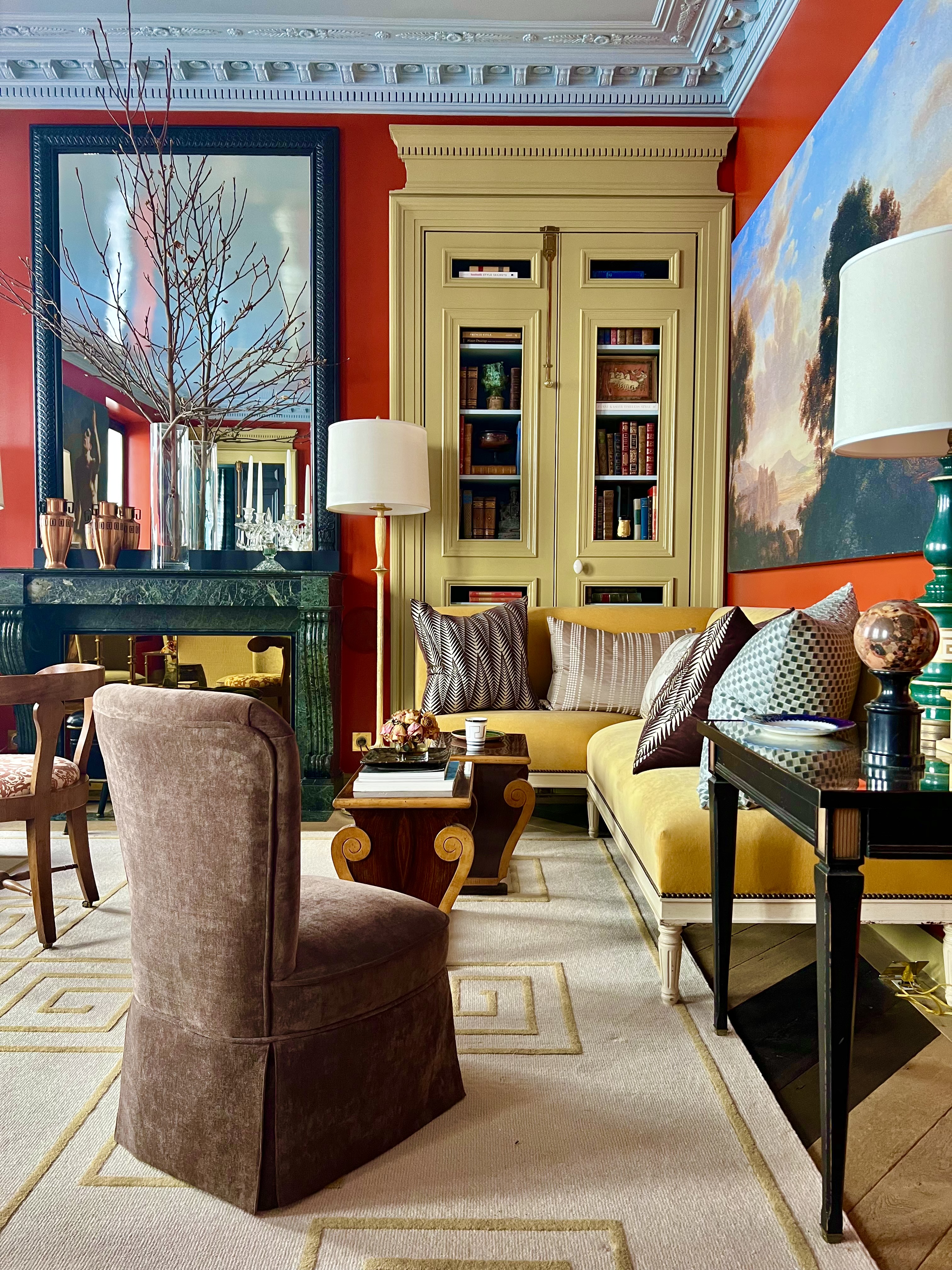
Want to choose the best bookshelves for your living room library? This idea by Garrow Kedigian, founder of Garrow Kedigian Interior Design could hit home. Give your book storage a stand out look with paint — choose a contrasting tone to the walls so it truly becomes the focal point. Here, to create more cohesion, the designer has chosen a sectional in the same tones as the bookshelf.
"Sometimes a bit of creative thinking can result in the happiest design accidents," shares Garrow. "There were a pair of closets flanking the fireplace in my living room. I loved the doors but thought it was awkward having closets in the living room so I had the contractor remove the solid panels on the doors and exposed the interior, which I lined with shelves to hold books."
2. Be bold with a color drenched library

This home library ideas by Marie Flanigan of Marie Flanigan Interiors sets a grand stage with the floor to ceiling bookshelves, dark paint, and comfy seating.
"This home, with its beautiful Georgian-inspired architecture, provided a unique opportunity to embrace its classic elements while bringing a fresh, updated feel," she shares. "Though the home was an extensive renovation, the original design included thoughtful details like symmetrical lines and elegant arches that we kept to make it feel more authentic and full of character. By honoring these Georgian touches, we were able to preserve the home's timeless elegance while ensuring it feels relevant and inviting in a modern context."
3. Fit it in a passageway
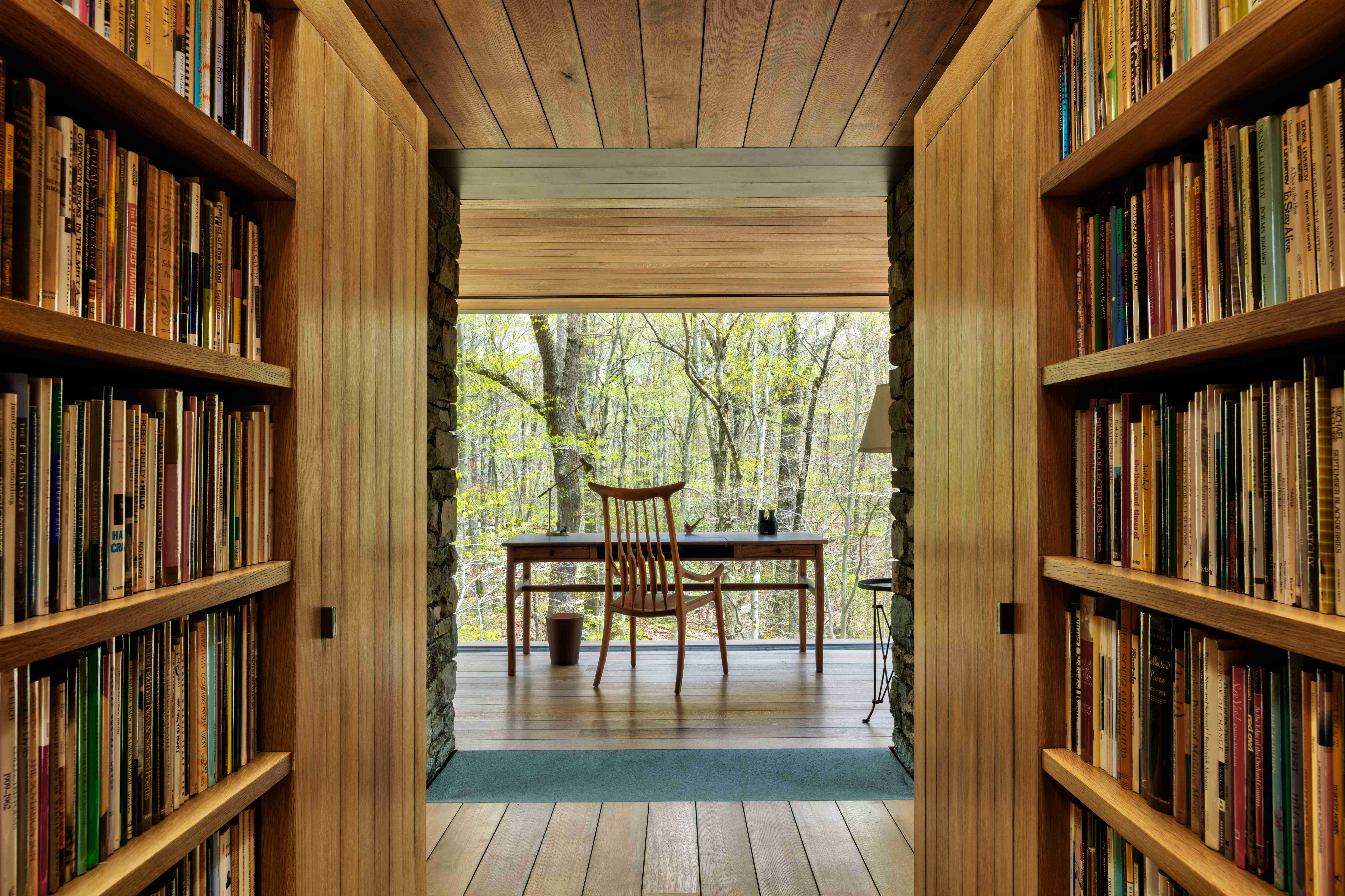
"Located within a writer's studio, this library is equipped to climatically preserve a rare, 1700-volume collection of poetry that came from a very good poet friend of the owner's," says architect Eric J. Smith. "Its design was to be, in the words of the owner — a poet himself — 'the beating heart' of his studio."
The space has great views of the outdoors, giving the reading space a whimsical feel. The large bookshelves made of wood have a truly vintage library feel. "The bookshelves are placed centrally in the studio, creating the only pathway leading from the entry door to the actual writing space, as seen beyond," adds Eric J. "The design intent was by having to walk past these walls of poets, the writer/ owner is reminded and inspired by those that have come before as he begins his new work each day. The space is a compact volume, with an intentionally lowered ceiling height, punctuated by two linear skylights. The floor and ceiling boards are of fumed oak, and give both direction and connection to the natural materials surrounding the studio."
4. Design a home library inside a spare room
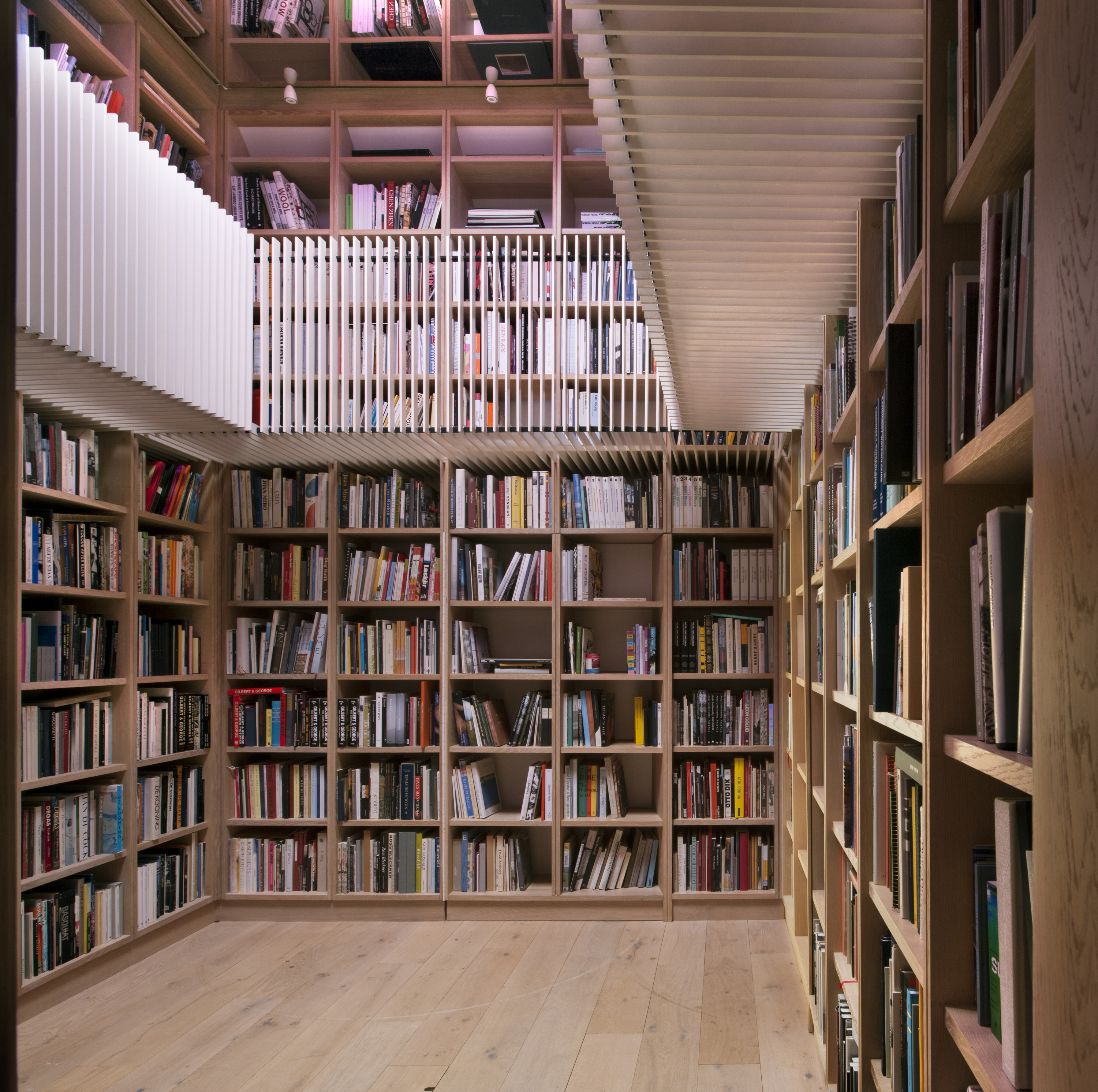
Reading rooms are a big and growing interior trend, and those who have the luxury of space and spare rooms in the house have the opportunity to dedicate ample space for books.
Take this library for instance that's designed inside a barn, and is conceived as a transitional space between the private and public spaces. "The idea was that once inside the library, one should feel fully surrounded by books, rather than walls," shares Christina Seilern, founder of Studio Seilern Architects. "The space is galleried, and the ceiling is mirrored, giving the sense that the library extends vertically into infinity. The four walls are covered in full-height bookshelves, within which four secret doors have been integrated. When closed, the space seems to have no exit, and one is fully immersed in this extensive and wondrous art book collection."
5. Build a library in your double height living room
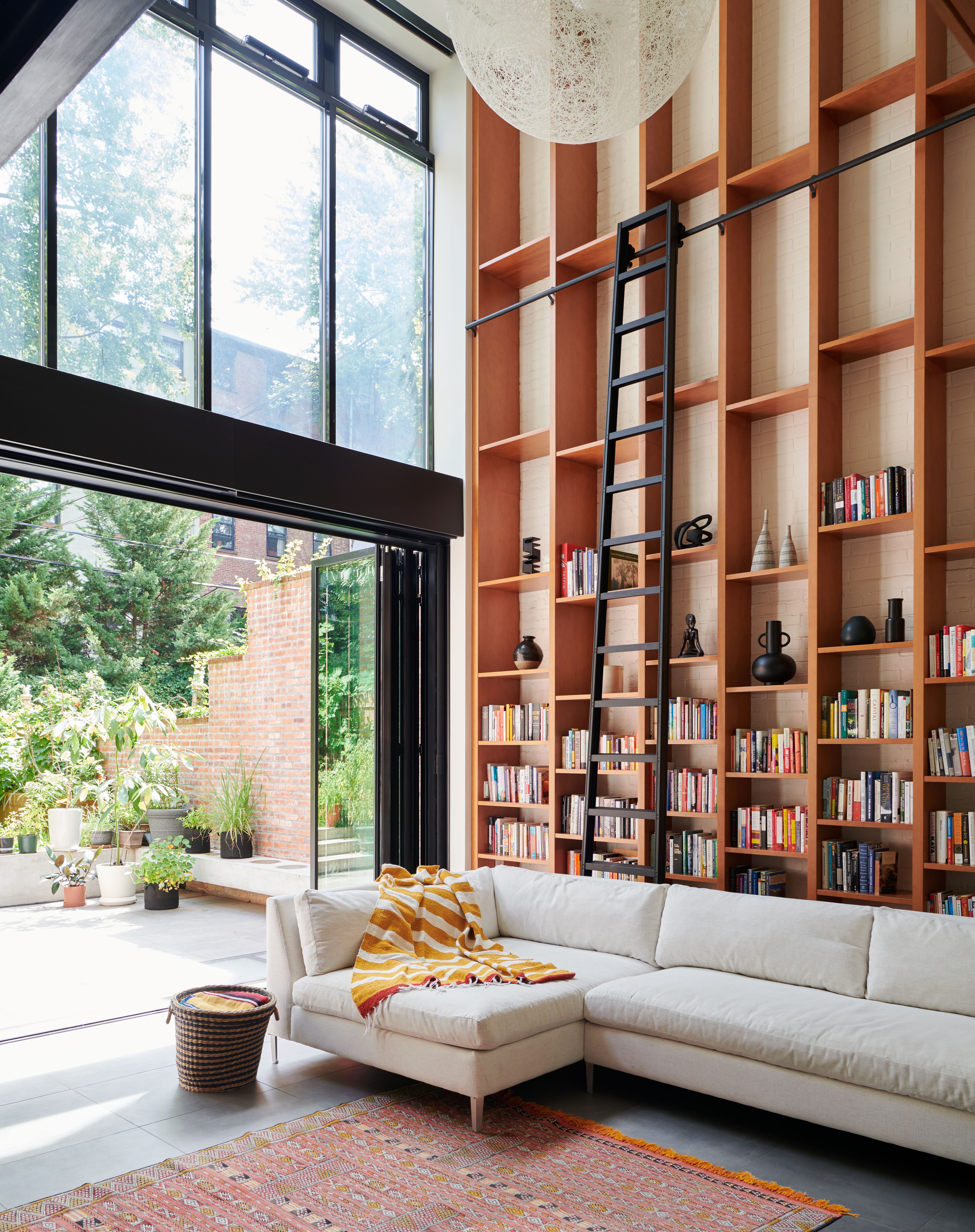
"In this Ft. Greene Brownstone, we removed a bit of the first floor to create a double-height living room opening onto the garden," says Jeffrey Sherman, principal at Delson or Sherman Architects. "In celebration of all that height, we proposed floor-to-ceiling, heart-pine bookshelves that can be reached by a metal rolling ladder. The lower shelves are for books, and the higher shelves are for the display area."
This built in storage space is also ideal for storing all the living room paraphernalia, and for displaying interesting artworks and collectives. The one-size-fits-all (quite literally!) is great for keeping the room clutter-free.
6. Create a slim bookshelf around the door frame
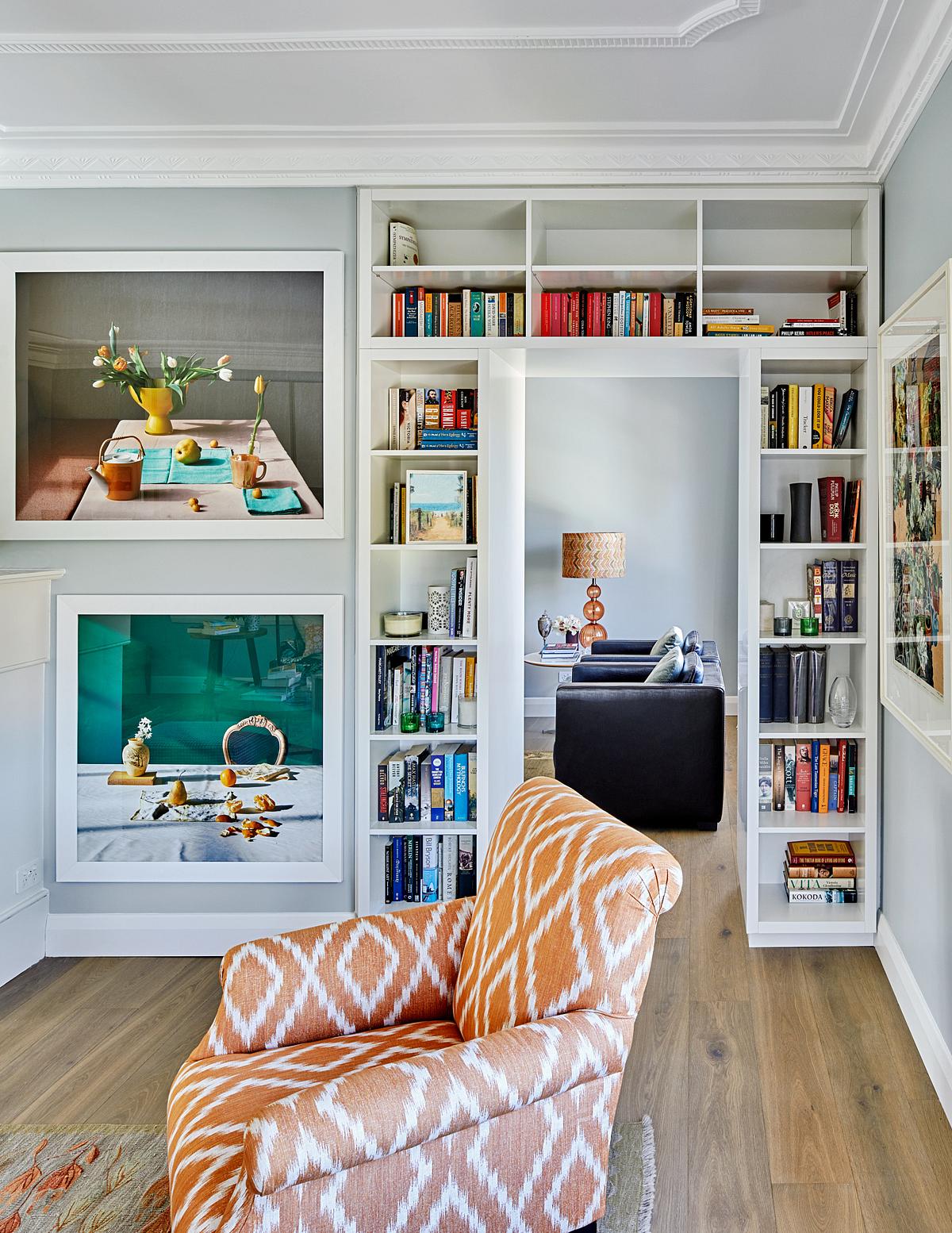
If space is at a premium then the best bookshelves for small spaces are ones built around the door frame. This is a great way to not only make your books easily accessible but also to add interest in transitional spaces. The books will wonderfully frame the door, add color to it, and encourage people to pause and take a look at it.
Along with books, you can also use the bookshelf to add other objects to make it look more decorated. "Vases, picture frames, storage boxes, souvenirs from a favorite trip, or an item passed down from Grandma are all good candidates," says Anna Popov of the eponymous Seattle-based interior design firm.
7. Have a library around a window seat
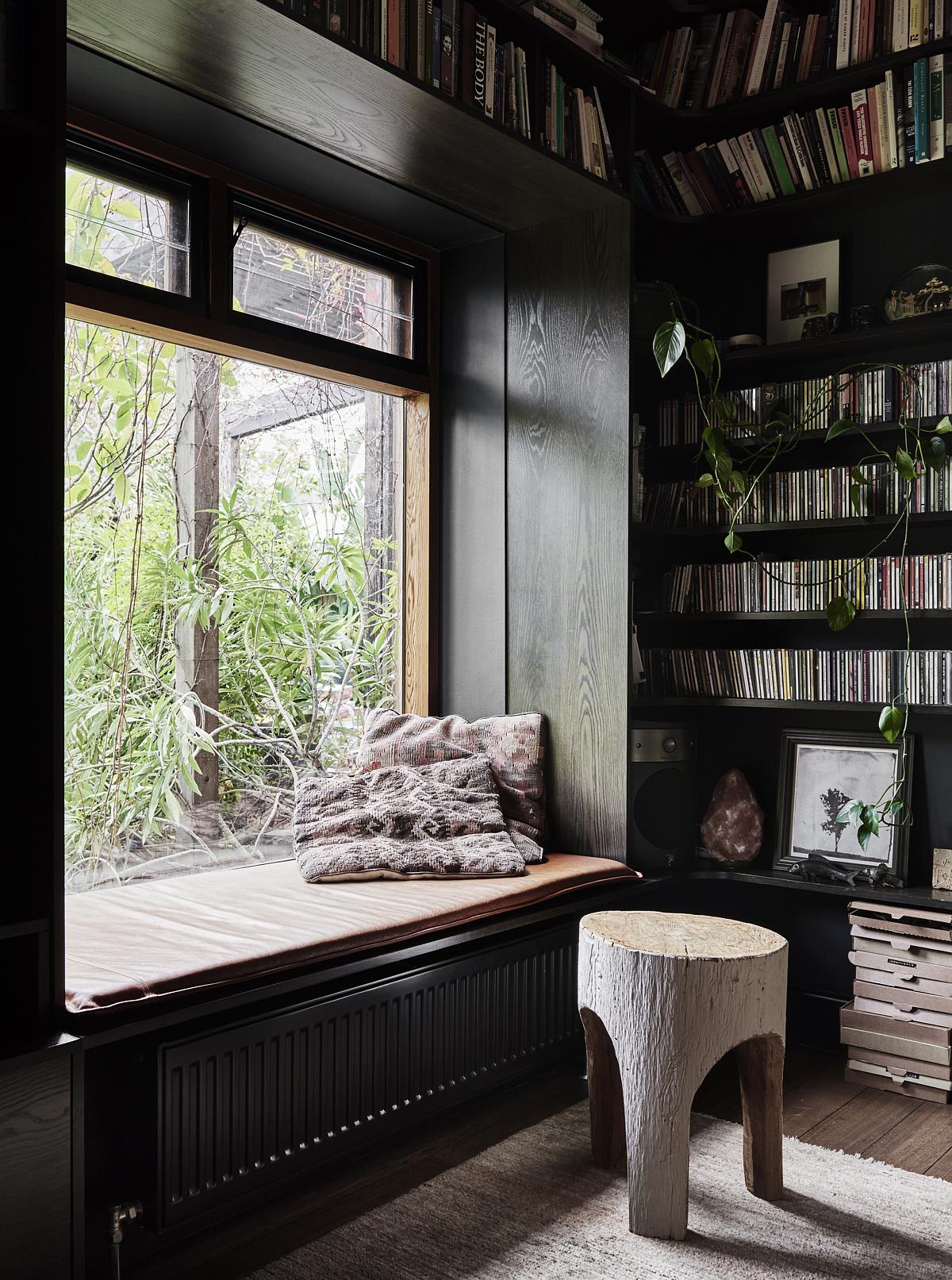
Nothing says snug better than a reading nook by a window seat. Make it cozier with pillows, a throw and a reading light. A dark-toned space like this by Kim Kneipp is especially inspirational as the black tone adds to the snugness of the space.
If your living room or home office doesn't have a seat by the window, you could always add a daybed here. "These pieces frame the windows behind them and provide the perfect opportunity to sink in after a long day at work," says Anjali Mangalgiri, founder of Grounded. "You can bring in a subtle play of some lovely textiles into the space with a daybed."
8. Add drama and depth with black painted shelving

Dramatic, inky shades are perfect for home libraries, adding elegance and sophistication. You'll also find that colorful books pop against a black background more so than they would lighter shades. We love the simple black-and-white scheme of this home library, warmed by the sumptuous jewel tones of the armchairs — the perfect spot for curling up with a book.
One thing to keep in mind while designing a slim bookshelf is knowing how to declutter books so they don't make the living room feel like a mess.
"Decide if you want your bookshelf to be filled with books, or have more of a decorative look to them," says Amanda Wiss, founder of NYC-based home organizing company Urban Clarity. "This will drastically change how many books you’ll fit on each shelf." And remember to donate the ones that are torn or are yellowing. Always display the best of your paperbacks in a room that is the home's main socializing spot.
9. Mix up your shelving
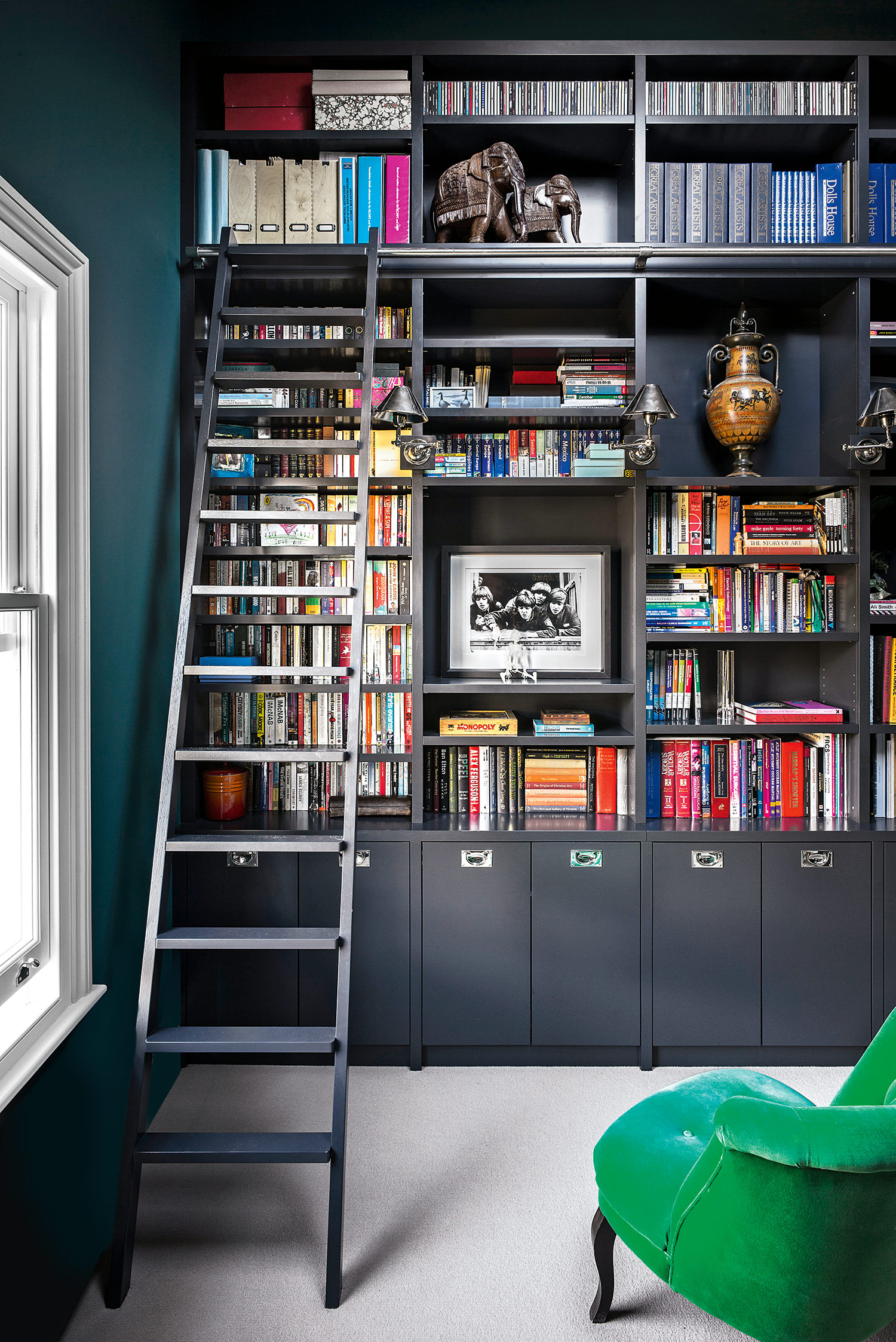
While a wall of shelving, all equally distanced apart with perfectly arranged books can be satisfying to look at, they don't always add the most interest to a room. A mix of shelving sizes and shapes creates a far more varied focal point to a room, and it allows you the space to look decorated too.
One thing to keep in mind though, is that with mixed shelving, you need to ensure that the contents inside feel coordinated and uniform otherwise the entire bookshelf will look a bit disheveled. "When choosing how to put books together on a bookshelf, instead of grouping by color, group by theme," says Rayman Boozer, an NYC designer and founder of Apartment48. 'This will transform the room. Perhaps you'll put books together on a similar subject, or that remind you of a particular moment."
Also, a lot of stacked books can sometimes confuse. Perhaps invest in bookshelves with lights so you can find the exact copy you're looking for, and it's easier to access the shelf.
10. Go for a minimalist design

Not all home libraries are traditional spaces, as this one proves. Built from plain materials, this minimalist bookshelf feels fresh and modern, and is one of the most on-trend home library ideas.
"I like using raw and natural materials lightly and poetically," says Ticiane Lima, founder of Ticiane Lima Arquitetura & Interiores. Next to this bookshelf, the designer added porcelain tiles. "To decorate the bookshelf, we reused books that were going to be discarded, so we just removed the covers so that they looked all the same but the color of the paper defines that they come from different times, so each one tells its own story."
11. Mix decor with your books
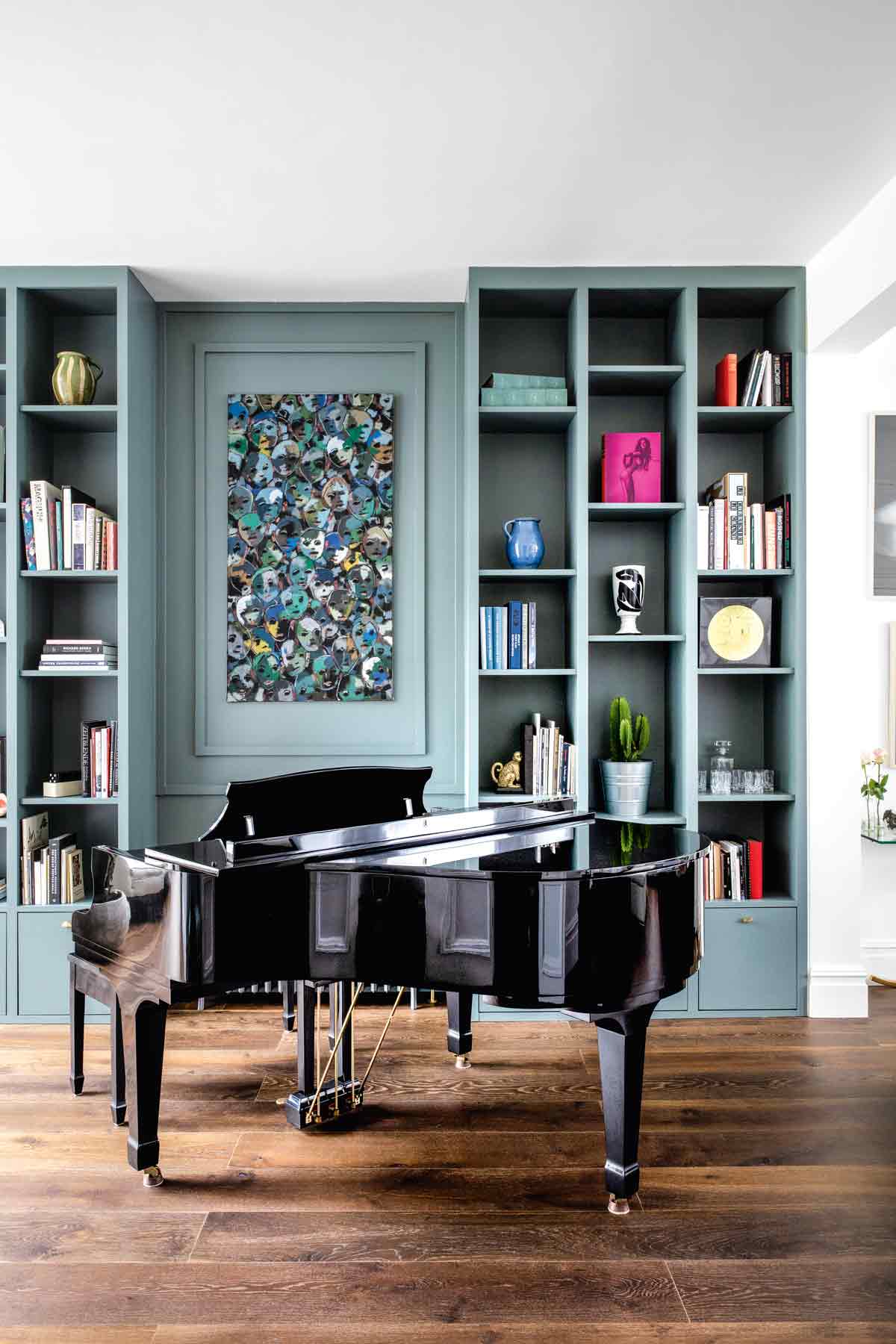
Because home libraries aren't all about the books. Make the space really personal to you by mixing in some decor. For decorating bookshelves, consider adding prints, photos, vases, houseplants, and more to add texture and interest to the bookshelves. You can also use these items to divide up your books.
"When styling bookshelves, always arrange things in odd numbers," says interior designer Mary Patton. "Also, if you opt for a bold color such as green, and do pick accessories that will pop with that color."
12. Create a uniform design with a grid layout
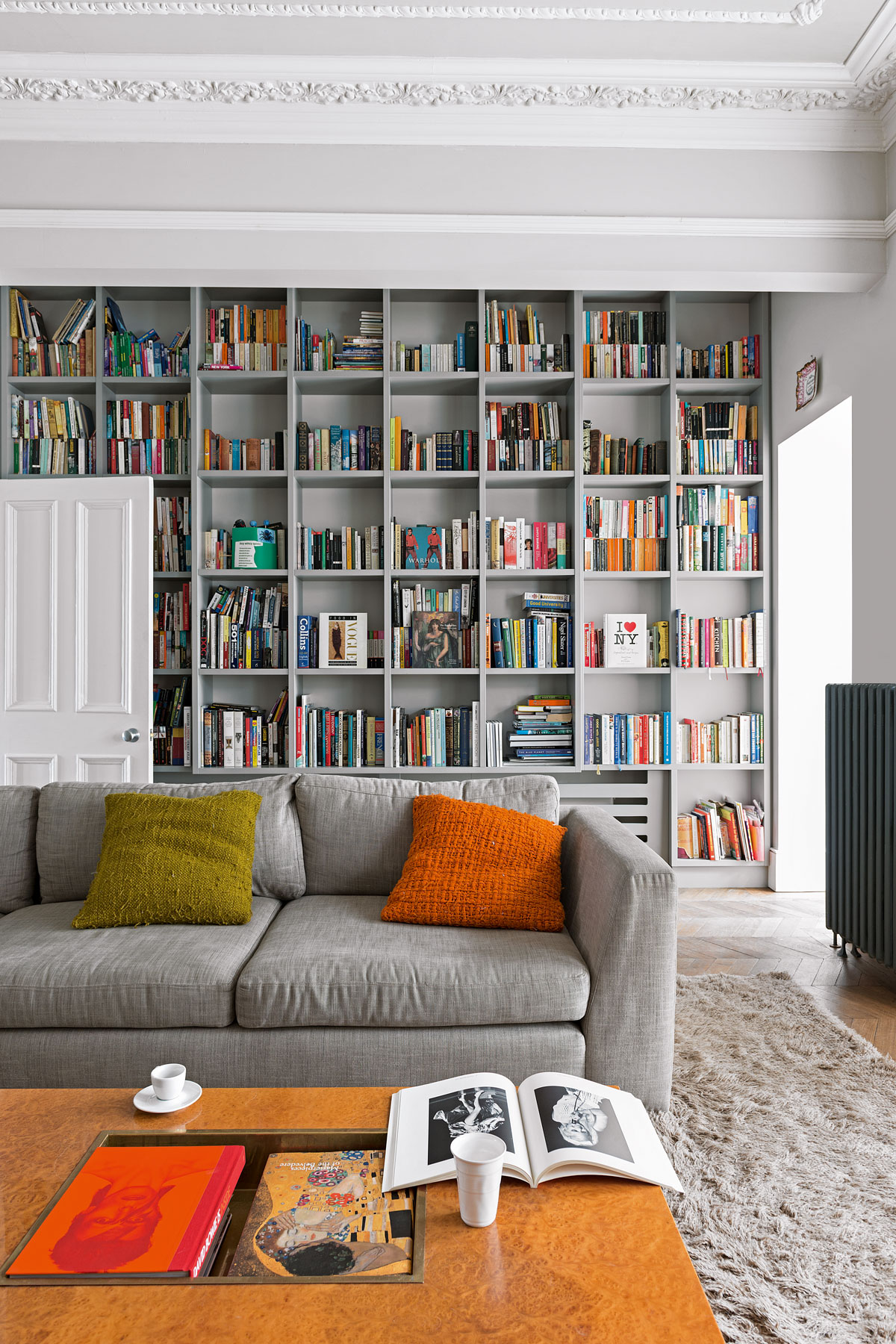
If you're looking for library design ideas that are simple and minimalistic, opt for a grid pattern. This is also a good book organization idea. It adds structure and symmetry to a room and feels uniform no matter how eclectic to make your displays. This layout means you don't have to be neat and precise with your styling — the shelving has done that for you, so you can get creative with what goes inside each cubby.
The only downside to this design is that all objects inside cubbies are visible at all times. You could, in that case, go in for an open and concealed shelving. "It gives maximum versatility, allowing you to display your most favorite pieces of art, books, and treasured objects, whilst concealing those day-to-day items that you may need to have to hand," says Rebecca Northmore of HUX London.
13. Don't be strict on how you display books
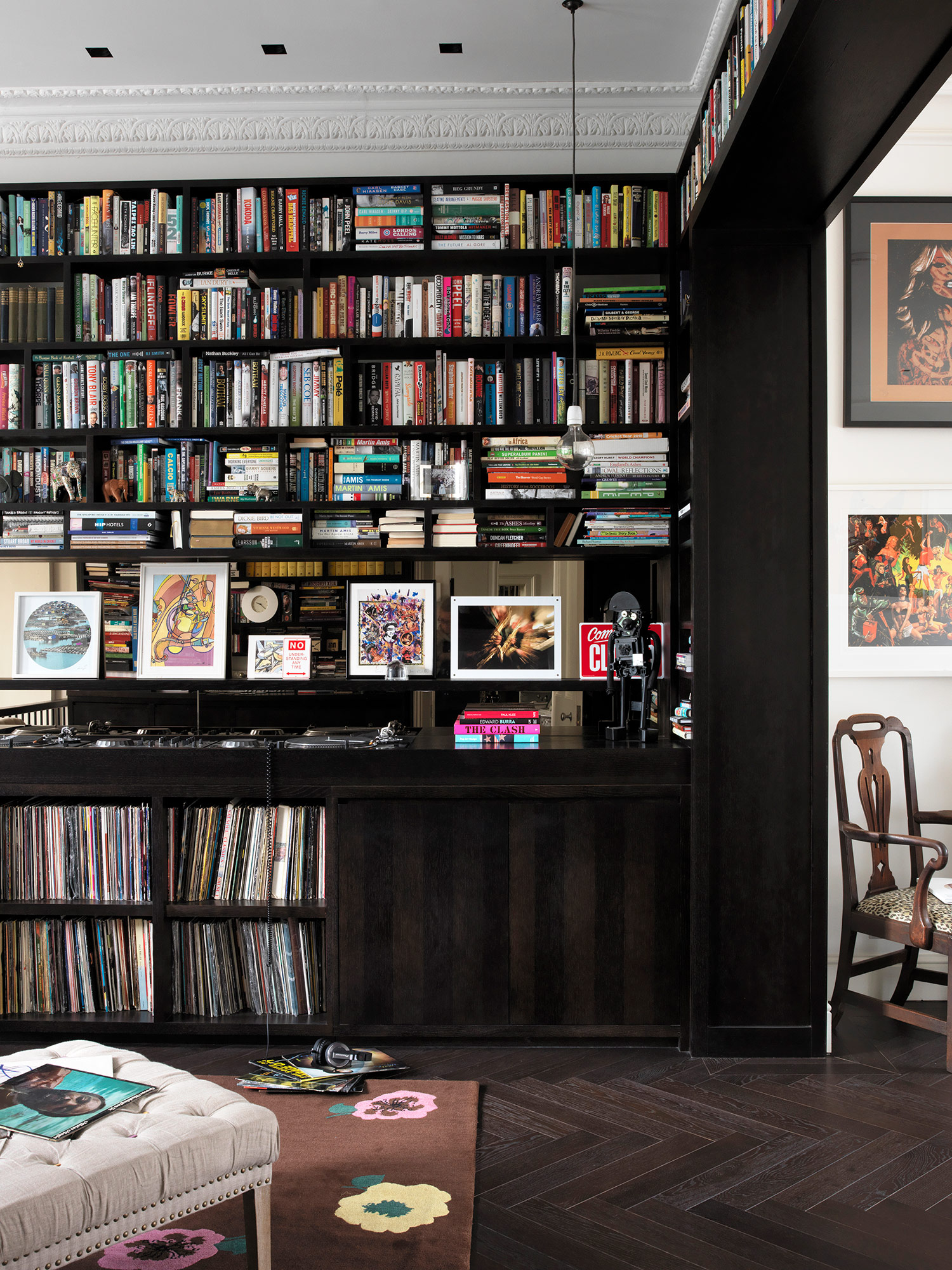
As satisfying as row-on-row of perfectly aligned books in color order might be, sometimes being more haphazard in your arrangement makes a bolder style statement.
Be inspired by this home library and cram your shelves with books — arrange them both horizontally and vertically and go spines inwards too so the pages are what you see first. See how these black bookshelves add so much texture and interest than perfect stacks.
"The different colors, textures, and prints on the covers will add eye-catching detail," says Emma Deterding, founder of Kelling Designs. "It will create a rainbow effect which is an effective way to introduce color and pattern to a space."
14. Make use of usual spaces
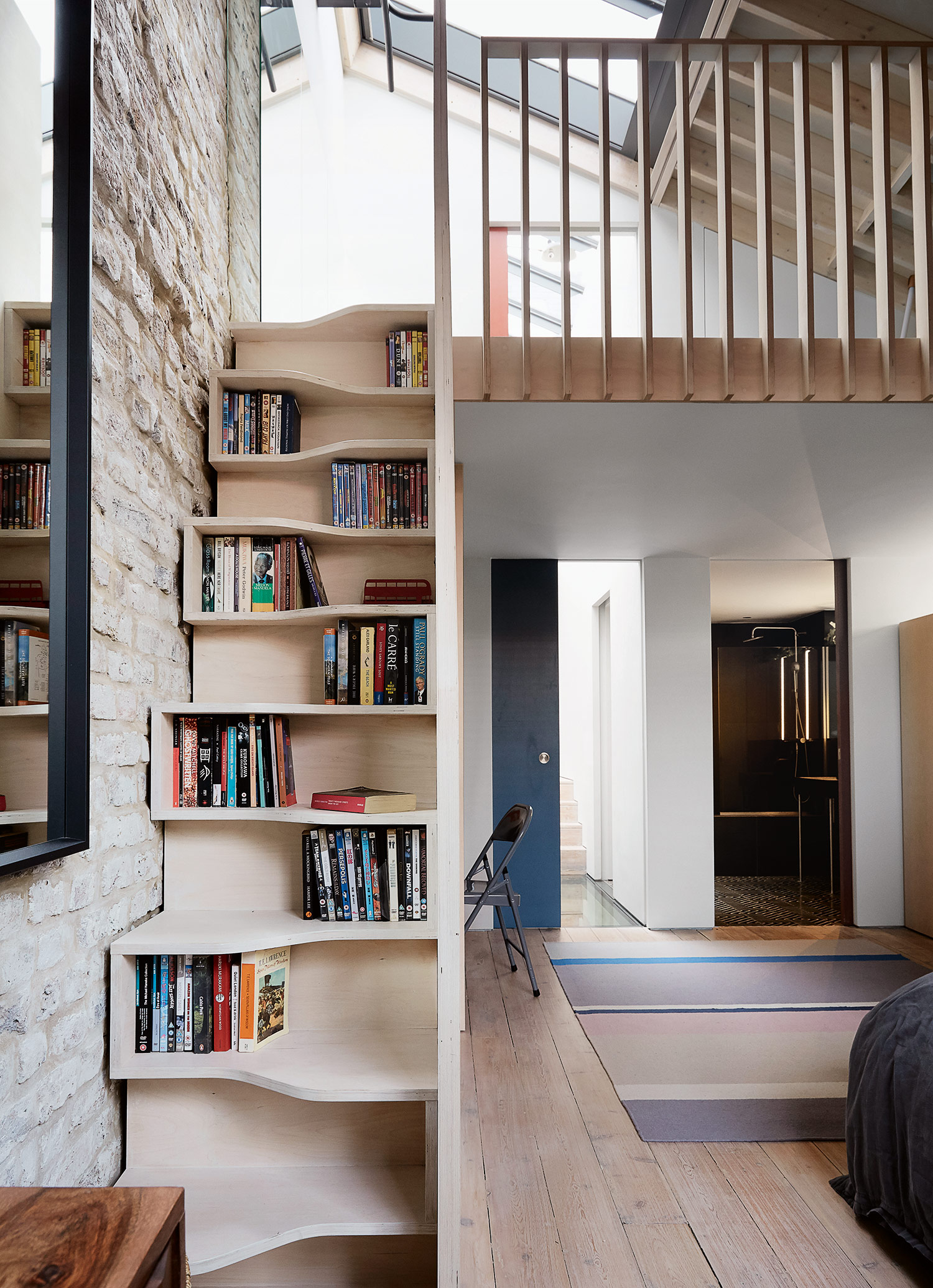
While this is not strictly a home library, book storage has been cleverly squeezed into the space, by turning the staircase into a bookcase.
While not easy to execute, if you do have the time and budget, then this idea could be an interesting one for a small modern home office; and it'll surely save space. Do remember to dust your paperbacks often, and perhaps keep the more important books in a cabinet or a more secure space.
15. Use a bookshelf to hide a TV
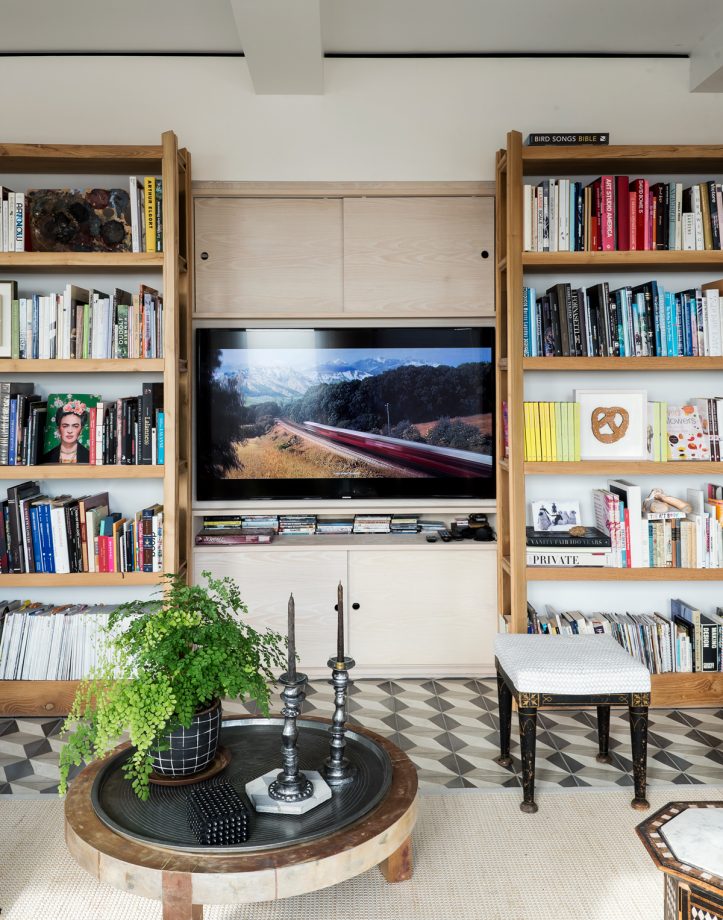
Looking to save space? This might be one of the cleverest home library ideas. The small living room TV idea, designed to hide the bulky tech has shelving units that just easily slide to each side revealing the TV plus even more handy storage.
To give an authentic library effect to your living room bookshelf, "store your books with the biggest at the bottom and the smallest at the top," says Samantha Wilson, interior designer and founder of Collection Noir, "maybe grouping them alphabetically, by author, or collection."
16. Give corridors a new purpose
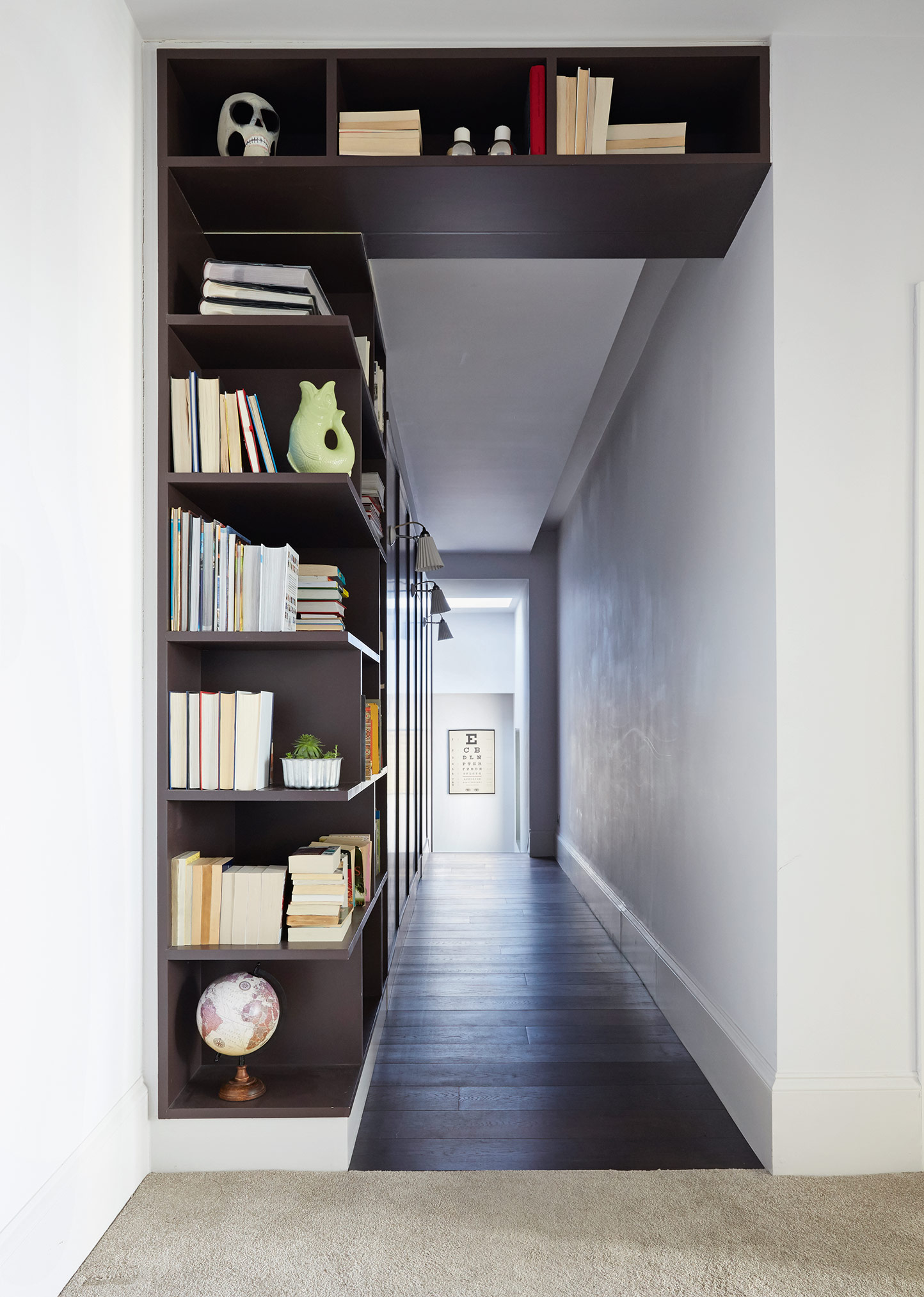
One of the best library ideas for homes is those in the entryway or hallway. The display shelving will be both practical and will make a stunning design feature. Just make sure your hallway lighting is planned in too — you want to be able to see your lovely book display. Add downlights or spotlights within the shelves to highlight your collection and stop the space from feeling gloomy.
"Unlike ambient lighting, task lighting does not brighten the rest of the room," says Meenu Agarwal, founder & interior designer at MADS Creations. "It is more functional than decorative and is used for activities that require closer inspection like reading. When installing these lights, first, consider additional light sources in the room." This will allow you to add task lighting like extra lamps or a pendant in a complementary location while maximizing the use of any current illumination.
17. Add interest to a landing

Similarly, staircase landings often don't get much attention. They tend to be small, awkward spaces that are tricky to add any decor to as floor space is so tight. But why not put that dead space to use and turn it into a home library? Books can double up as decor and add plenty of color and texture to a landing without taking up lots of precious floor space.
You can also add other features to the landing to further accentuate the space. Think artwork, wall paints, or a tall plant. These will complement the bookshelves. For an elevated, architectural feature, think paneling. "Staircase paneling is great because it creates a natural transition between the levels," says Diana Rose, principal, and creative director at Diana Rose Design.
18. Build lighting into your home library
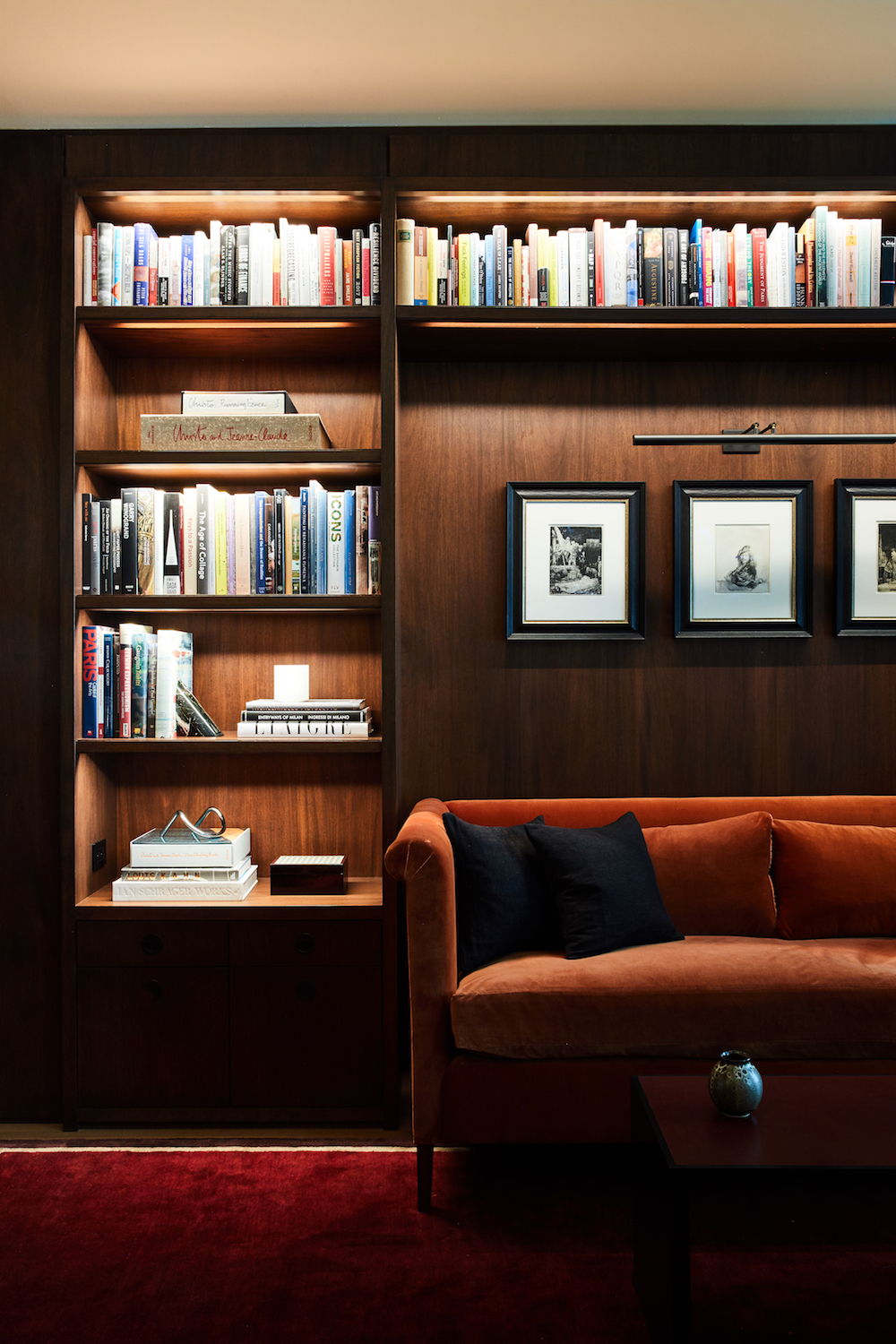
Built-in lighting is a chic and elegant way to illuminate your book collection, plus it creates a lovely gentle glow to the room that ups the coziness.
Consider recessed LED lighting as "these are energy-efficient, consuming significantly less electricity compared to traditional lighting options," says Sarah Brady, founder and principal designer of Salt Design Company. LED strip lights or LED canless lights from Walmart are versatile and can be easily installed in various locations.
19. Choose sleek design
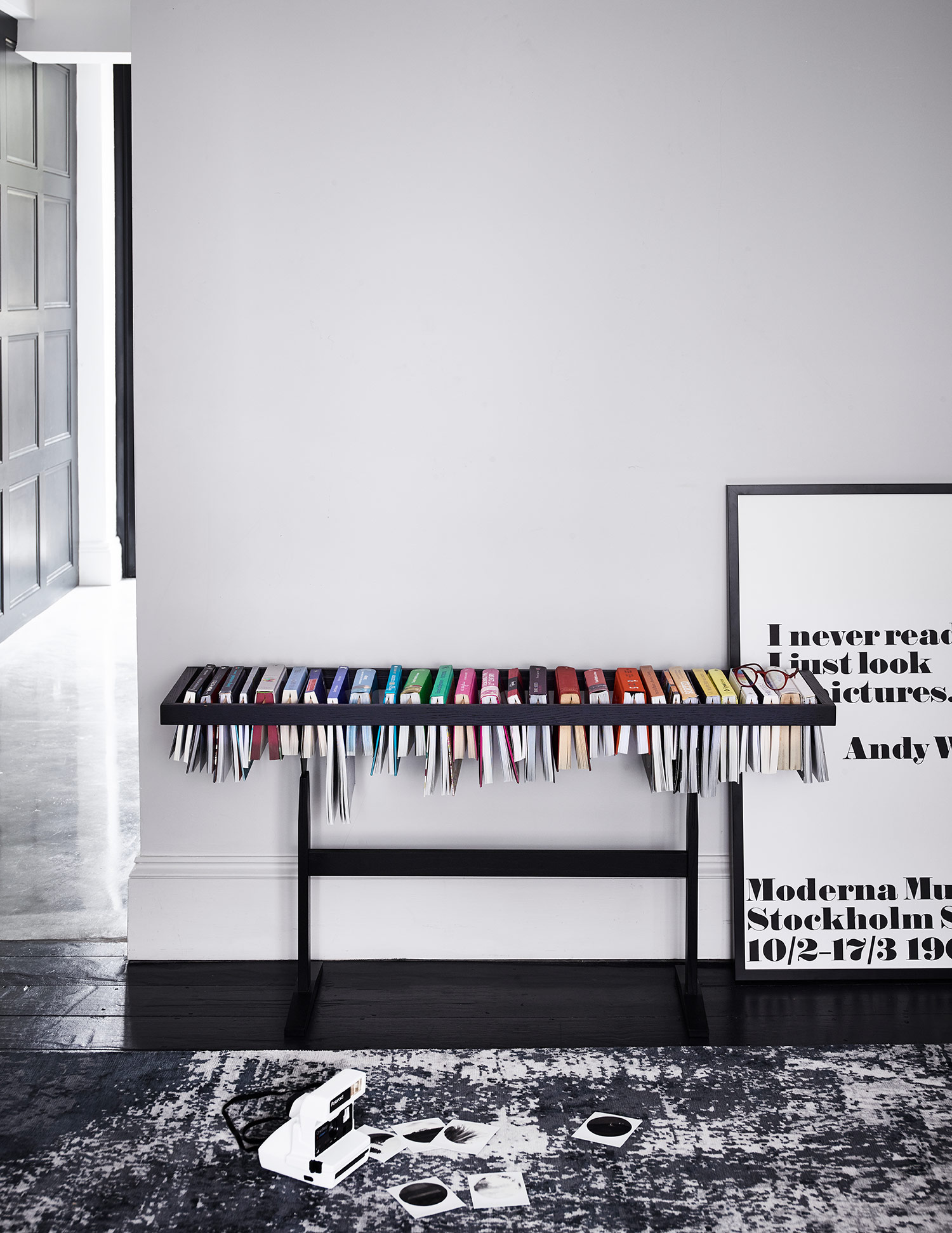
This is one of the ways designers make home offices better — with a space-saving, minimalist bookshelf. We adore the LEMA Booken bookcase — a design classic.
In this design, the books move out of the background to become a design feature in their own right, banding together on a series of oak bookmarks to work not only as a nifty, hanging library, but as a stylish side table and shelf for resting your cup of tea on.
While a horizontal rather than vertical library takes a bit of getting used to, soon you won’t want anything else — just think, no more neck ache craning to find the right book and, thanks to the built-in bookmarks, no more losing your place or resorting to the sinful practice of thumbing-down pages.
20. Build a bookcase into an awkward nook

Awkward angles may be a pain when it comes to decorating, but there's no denying they make for lovely reading nooks. So embrace your unusually shaped spaces and transform them into a home library by building in floor-to-ceiling bookcases. Add a comfy chair and a floor lamp if you have the space too, to create the perfect spot to get stuck into a novel.
"For an easy reading spot, all that is required is a designated area that makes you feel cozy and comfy,' says Julia Mack, founder of Julia Mack Design. "Just add a comfy chair, a small table and a directional floor lamp."
21. Use a freestanding bookcase to break up a room
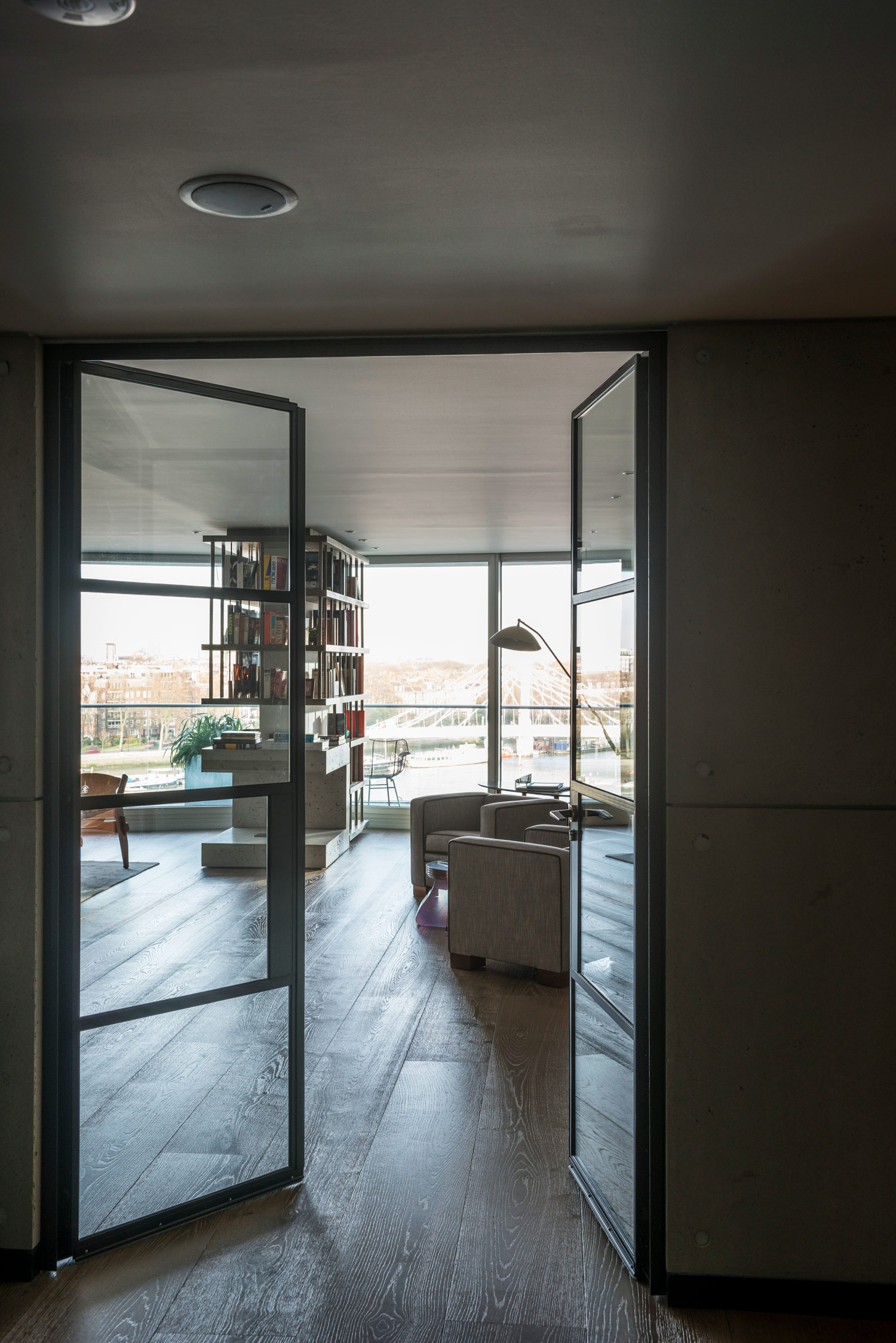
Designer Tara Bernerd used this central, concrete and wood bookcase to not only house her treasured possessions (and her TV), but also as a way to cleverly break up her open plan living into two functional areas.
What makes this design special is that the bookshelf and the books are accessible from both sides of the room. The floating, built-in shelves add fluidity and a sense of openness to the design, so the room doesn't feel too closed.
How can you add a small home library?
A home library might sound like it can only exist in large homes with a never-ending amount of spare rooms, but to us all a home library means a spot to store your books, maybe a cozy armchair to enjoy said books from. And really you can create that in any room, no matter what size.
So to add a small home library, find a nook in your home that's going unused — an alcove, under the stairs, in the closet, a home office, an attic space and build in some shelving. For really awkward spaces we'd recommend going bespoke to just make the most of the room you have. Then just fill the shelves up with books, and in a spot to read from and some soft lighting, and there you have a home library.
What should every home library have?
Every home library should of course have books, but there are other things you can bring into your space as regards to style and comfort. Seating is a nice addition to a home library if you have the room, providing you with a place to perch and read surrounded by your collection. And getting the lighting right is important too, as you want the space to feel cozy but also have a light that's strong enough to read by. Always place a task light next to where you will be reading – floor lamps work perfectly but also dot other light sources around the room to get a lovely all-over glow.
In terms of decor, try mixing in other pieces amongst your books like artwork, photographs, and plants to make the space feel more personal. And always throw down a rug to add some comfort underfoot and make the room feel inviting.
Be The First To Know
The Livingetc newsletters are your inside source for what’s shaping interiors now - and what’s next. Discover trend forecasts, smart style ideas, and curated shopping inspiration that brings design to life. Subscribe today and stay ahead of the curve.

Aditi Sharma Maheshwari started her career at The Address (The Times of India), a tabloid on interiors and art. She wrote profiles of Indian artists, designers, and architects, and covered inspiring houses and commercial properties. After four years, she moved to ELLE DECOR as a senior features writer, where she contributed to the magazine and website, and also worked alongside the events team on India Design ID — the brand’s 10-day, annual design show. She wrote across topics: from designer interviews, and house tours, to new product launches, shopping pages, and reviews. After three years, she was hired as the senior editor at Houzz. The website content focused on practical advice on decorating the home and making design feel more approachable. She created fresh series on budget buys, design hacks, and DIYs, all backed with expert advice. Equipped with sizable knowledge of the industry and with a good network, she moved to Architectural Digest (Conde Nast) as the digital editor. The publication's focus was on high-end design, and her content highlighted A-listers, starchitects, and high-concept products, all customized for an audience that loves and invests in luxury. After a two-year stint, she moved to the UK and was hired at Livingetc as a design editor. She now freelances for a variety of interiors publications.
-
 12 Essentials Every Cool, Collected Spring Host Needs — And You’ll Never Guess Where They’re From
12 Essentials Every Cool, Collected Spring Host Needs — And You’ll Never Guess Where They’re FromGuests will think you thought of everything, you just knew where to shop
By Julia Demer Published
-
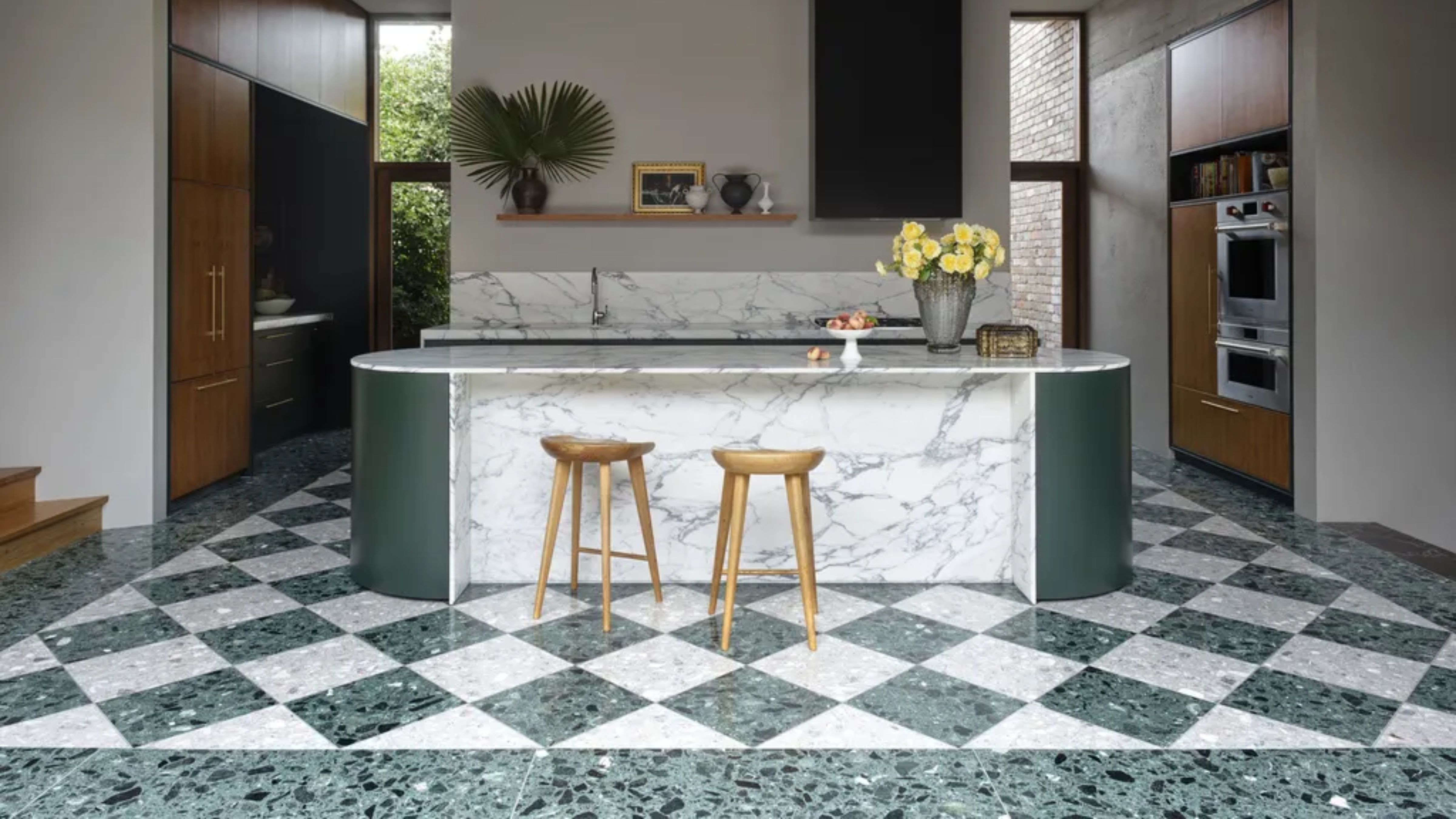 Smeg Says Teal, and We’re Listening — The Kitchen Shade of the Year Is Here
Smeg Says Teal, and We’re Listening — The Kitchen Shade of the Year Is HereDesigners are already using the soft, sea-glass green everywhere from cabinetry to countertops
By Julia Demer Published



